Market Structures Essay
Introduction, types of market structures.
In an ordinary market structure, there is the assumption that there are several and different sellers and buyers. The result of this is fair competition where price of goods is determined by the forces of demand and supply. This is so because, in such a market, both the seller and buyer are equally able to influence the price.
However, this is not always the case. Some market industries have only a single seller or much fewer sellers than consumers, limiting the buyer’s ability to influence the price. This paper discusses the various market structures that exist in our market today and the various pricing strategies that could be applied in their management.

Pure monopoly
This type of market exists when there is only a single seller controlling the supply of goods or services in the entire market. He alone can control the price and prevents other businesses from entering the market. They commonly exist in a government-regulated setting. A case in point is the provision of electric and Natural gas utilities in the United States.
The government is the sole provider of these utilities and regulates their delivery to the public through the state, federal and local agencies. The prices are not arrived at through the forces of demand and supply but by the structures of the government. “The agencies govern the prices they charge, the terms of their services to consumers, their budgets and construction plans, and their programs for energy efficiency and other services,” (Regulatory Assistance Project 2011, P. 3).
Competition in this sector cannot thrive since the government provides subsidies to these utilities so as to provide cheaper services to the public, something that small private entities are unable to do. In addition, the infrastructural and technological requirement for the provision of the services would be so much of an expense for a private entity to meet.
Even though the government is the price maker here, it cannot set prices at a level that the consumer will not be able to afford if it wants to make profits. To set the prices, the monopolist should use the market demand curve and use it to set its own prices. The position marginal revenue for the monopolist should be less than the marginal revenue (MR). The position and elasticity of the demand curve works to limit the pricing mechanism of the monopolist.
The firm can only make maximum profits, on a short term, where the additional cost used to produce one more unit is equal to the resulting revenue from that one unit. For normal profits, the average revenue (AR) should be equal to the Average Total Cost (ATC). In the long run, the firm will only make profits where the AR is greater than the average cost (AC). (Mcconnel & Brue, 2009)
Pure Competition Market structure
This is a kind of a market where no single entity monopolizes the price determination process. Prices of goods are determined by forces of demand and supply and every player in the market has a part to play. A classic example would be a street vendor business.
In this kind of business, there is a large number of buyers and sellers and anyone may enter or leave the market at will without any barrier to doing so. Both consumers and producers are well informed of the prices and quality of goods and goods are homogenous across the market without much differentiation.
Every partaker is interested in maximizing profits as opposed to monopolizing the market whose returns are non-increasing to scale. Factors of production are freely mobile within the market with flexibility to ever-changing market circumstances. There are no new firms in the industry thus the same number of firms remains throughout.
In this market, the price is normally given by the demand and supply curve, as determined by the market forces, hence referred to as a ‘price taker’. The firm will sell its products at the current market prices and has no power to alter those prices. The stock is fixed while the supply curve will be perfectly elastic. In the short run, the firm can try to increase supply by increasing variable inputs. Profit will be maximized when MR is equal to MC. The firm must however fix their output to the prevailing market prices.
In the long run, the firm may change their unit of output as new firms enter the market. Supernormal profits will be realized where AR is greater than AC. When AR is greater than AC small firms starts quitting the market resulting into a decreased price. This will go on until AR is equal to AC and the firm makes normal profits. (McConnell & Brue, 2009)
Monopolistic Competition
This is a form of market where sellers deal with competitive products but which are differentiated from one another. It is almost like a perfect competition but though there are many firms in the industry, the products of each company are differentiated to make them unique to products of other firms.
An example is the Nike shoes. Even though many firms make shoes, which are equally competitive, only Nike makes that kind of shoe and one cannot obtain it from any other firm. The shoe is homogenous and specific to the firm and their differentiation gives monopoly over Nike to make the shoe alone.
Here, just like perfect market, the firm will take the market prices as determined by rival firms and will be forced to disregard their own influence on prices. In the short run, the firm may determine the prices depending on its level of differentiation and will have the same effects as a monopoly making huge economic prices.
However, as time goes by and competition increases, the effect of differentiation loosens gradually and the market changes to a perfect competitive one, with less profits. At the optimum quantity of production and optimum price, the firms will now earn normal profits. The equilibrium point, no new firms will be entering the industry.
Oligopoly market structure
This is a situation where there are few sellers of a commodity. The commodity being sold is however very similar but not identical to the others in the market. Products are close substitutes of each other but each firm has monopoly power over its own product. It also includes a duopoly where there are only two firms dealing with the product, e.g., Coca-cola and Pepsi. These two companies are the only known producers of carbonated soft drinks, yet their products are differentiated from each other.
For other firms to enter the market, they will require heavy investment and highly developed technology and incur high costs of promotion, thus posing a major barrier to entry of new firms and competition. The existing firms may also decide to merge, presenting even more difficulty to new entry. Both sellers have a substantial amount of influence on the pricing policies but there is mutual interdependency in price. The prices therefore remain relatively stable.
In this case, the pricing of Coca-cola will affect Pepsi’s price appreciably and the vice versa. Therefore, the best way is to agree, as between the two firms, on a pricing policy that is comfortable to the two firms. When such collusion of price determination occurs, the firms agree on an identical price, normally high, maximizing their profits and minimizing the production costs.
The pricing may be done through cost-plus pricing, which involves adding percentages of profit margin to Average Variables Cost to obtain the price. It may also be arrived at through the Mark-up pricing. Here the percentage mark-up it predetermined to cover the average margin. The AVC is estimated through the units of output produced over a given period of time. The level of output is used to determine the average cost.
Monopsony competition
Denotes a situation where one buyer buys from several existing sellers and he is therefore, the main determinant of the price in the entire market.
It is mostly found in the market for the exchange of factor services. The price he sets is lower than the market price and the quality exchanged is not correspondent to the price. For example, major sports clubs such as the National Baseball Association (NBA).
A baseball player wishing to be professional baseball player can only seek employment from NBA only. NBA will determine the minimum factor price which the player will and can take.
Though the monopsony is the price maker, if he wants to obtain quantity services, he has to part with a higher price or incur additional expenses or wages to hire more workers. The additional wages will enable him to earn more profits. These additional expenses are the marginal factor cost and the additional profits are the marginal revenue product. For maximization of profits, the firm should hire the quantity equal to the marginal factor cost and marginal revenue product, where these two curves meet, (Africa Awards, 2011).
The basic assumption of the existence of a perfect competitive market therefore, rarely exists. We have seen that there are markets dominated by one or two sellers or even one buyer.
Each market structure’s existence, however, is dependent on its power to influence the market price. There are also other minor types of markets that exist apart from the ones covered in this paper, for example a bilateral monopoly-duopsony, a market with two buyers and one seller. Also
Bilateral oligopoly-monopsony; one buyer and few sellers. However, all these are embedded in the five main ones discussed above.
Africa Awards. (2011). Market Structures: Monopsony , AmosWEB Encyclynomic WEB*pedia. Web.
McConnell, Campbell., & Brue, Stanley. (2009). Microeconomics: Principles, problems, and policies . New York: McGraw Hill. (18th Edition).
Regulatory Assistance Project. (2011). Electricity Regulation in the US: A Guide, Home Office, 50 State Street, Suite 3, Montpelier, Vermont 05602.
- Chicago (A-D)
- Chicago (N-B)
IvyPanda. (2023, December 9). Market Structures. https://ivypanda.com/essays/market-structures/
"Market Structures." IvyPanda , 9 Dec. 2023, ivypanda.com/essays/market-structures/.
IvyPanda . (2023) 'Market Structures'. 9 December.
IvyPanda . 2023. "Market Structures." December 9, 2023. https://ivypanda.com/essays/market-structures/.
1. IvyPanda . "Market Structures." December 9, 2023. https://ivypanda.com/essays/market-structures/.
Bibliography
IvyPanda . "Market Structures." December 9, 2023. https://ivypanda.com/essays/market-structures/.
- Augmented Reality in Business Applications
- Virtual and Augmented Reality in Ten Square Games
- Subsequent Cloning of PARK2 Gene
- Similarities Between Capitalism and Socialism. Compare & Contrast
- Compare of Capitalism and Socialism
- Money and Modern Life
- The mysteries of Capital
- Relationship Between Economic Woes and Having Children

Market Structure
Introduction.
The collection of buyers and sellers of a product is called its market. Markets differ significantly in terms of their features. For example, the market for wheat has different features as compared to the market for utilities. The way firms operate in a particular market and take different decisions depends largely on the type of market they operate in. In this article, we will explain different types of markets based on their features.
What is a Market Structure?
Market structure refers to the characteristics of a market that determine the behaviour of firms operating in that market. In other words, market structure is the set of features of a market that determine the way firms compete and make pricing and output decisions. In microeconomics, the concept of market structure is very helpful in understanding the behaviour of firms in terms of pricing decisions, output decisions, and other ways of competing.
The behaviour of firms depends on the market structure they operate in. It means that firms operating in the same market structure behave in the same way, while firms operating in different market structures behave differently.
Characteristics of Market Structure
The following are some important characteristics of a market structure:
- Number of firms
- Market knowledge
- Market power
Product Differentiation
- Entry barriers
- Exit barriers
Let us explain these features one by one.
Number of Firms
The number of firms operating in a market is a major feature of its structure. The number of firms can vary from one to hundreds and thousands. If a market has too many firms (perfect competition) working in it, it is considered a good market structure in which firms are in healthy competition. Under competitive pressure, these firms allocate resources in an efficient way. But if there is only one firm (monopoly) or a few firms (oligopoly) dominating the market, then this market is considered different in terms of the way firms compete and make their decision about resource allocation.
Market Knowledge
Market knowledge is the information available to buyers and sellers. In some markets, there is perfect knowledge or perfect information, which means that all the information is freely and easily available for buyers and sellers. In other markets, there are secrets and the presence of asymmetric information.
Market Power
Market power refers to the ability of a firm to influence the price in the market. It is also an important determinant of the type and structure of the market. In some markets, firms have no market power and they cannot influence the price. These firms are called price takers. In some other markets, firms have the power to influence the market price and are called price makers or price setters.
Product differentiation is another feature which determines the type of market structure. In some markets, firms sell homogeneous products, which are perfect substitutes. In some other markets, products are differentiated.
Entry Barriers
Entry barriers are the hurdles faced by new firms when they try to enter the market. It is also an important feature of market structure. Some markets have low barriers to entry and new firms can freely and easily enter the market. Some other markets have high entry barriers, making it difficult for incumbent firms to enter the market.
Exit Barriers
Exit barriers are the hurdles faced by existing firms when they try to leave the market. When there are no barriers to exit, existing firms can easily and quickly leave the market.
Types of Market Structure
The following are some types of traditional market structures: In all of these types of markets, we assume that there are a large number of buyers.

Perfect Competition
Perfect competition is a market structure in which a large number of small firms compete with each other in the market. It is also called pure competition or atomistic competition . In a perfectly competitive market, new firms can easily enter or exit the market and sell homogeneous goods. An individual firm has no market power and cannot influence the market price. That is why; firms in this market structure are price takers. In this type of market structure, customers have access to all the information about the market. There is no asymmetry of information between buyers and sellers, and consumers are aware of the prices, seller locations, availability and quality of products. This type of market structure is rare to find in this world. However, this concept is useful when comparing other market structures.
In perfect markets, firms are assumed to sell at prices where marginal revenue becomes equal to marginal costs to generate normal profit.
Critics thought this market was unrealistic, and then this market structure faced different criticisms, which are described as follows:
Lack of Economies of Scale
Critics argue that due to the small size of firms and there low market shares, firms do not enjoy economies of scale and hence cost cannot be further decreased. This can be a missed opportunity for cost reduction and efficiency improvement, which are possible through economies of scale.
No Incentive for Innovation
Critics argued that there is no incentive for innovation in this market. Normally, firms, in order to remain in competition and hold a large portion of market share, prefer to innovate to beat their competitors and remain at the same market share. But in this type of market structure, product prices are fixed; firms are price takers and they cannot increase or decrease the prices of products. This leads them to earn normal economic profits, which may not be enough to invest in innovation, leading to a lack of dynamic efficiency.
Monopolistic Competition
An imperfectly competitive market, which has both the qualities of a monopoly and a competitive market, is called monopolistic competition. There are many firms in this market and there are low entry/exit barriers. In monopolistic competition, seller firms compete and differentiate their products from each other to attract more consumers. In this market structure, product differentiation gives firms the power to increase the price slightly and become price makers.
There are many different aspects that are considerable when observing monopolistic competition, both short-term and long-term.
In the short term, monopolistic firms can charge their product prices on their own and enjoy abnormal or supernormal profits. The profit maximisation output and the price are determined by using marginal revenue (MR) and marginal cost (MC) curves (MR=MC). But marginal revenue becomes low and eventually diminishes when new firms enter the market due to low entry barriers. Due to this reason, in the long run, only normal profits are earned by firms in monopolistic competition.
Theoretically, a monopoly means a market structure in which there is a single firm with 100% market share. In real life, a monopoly is a market structure with more than 25% market share. In economic theory, we discuss a monopoly as the sole producer of a good or service. In this type of market structure, a single seller dominates the whole market and faces no competition due to very high entry barriers. These high entry barriers make it impossible for new firms to enter the market. In other words, in a monopoly market structure, firms are the sole owners of resources and have claims, copyrights, licences, and patents issued by the government with high initial set-up costs. Due to these factors, no one can easily enter the monopoly market structure. That is why the firm working in a monopoly structure is the single seller and has the power to manipulate prices according to their will to generate supernormal profits. Monopolist firms can further maximise their profits by using price discrimination, which converts consumer surplus into firm’s revenue. A natural monopoly is a firm that becomes a monopoly due to the cost structure of the industry.
A market structure in which there are a small number of big firms that offer differentiated or identical products is called an oligopoly market. In this type of market structure, firms are interdependent and the actions of one firm will affect the other firms. The strategies used by firms depend on the actions of other firms. Due to this interdependence, firms can also indulge in collusive behaviour to maximise their joint profits. For example, firms can sign agreements to share the market by limiting the production of goods. This will lead to enormous profits. In this type of agreement, they can perform like monopolies, and the formal collusion between them is termed a cartel.
In this market structure, barriers to entry and exit are high due to the availability of advanced technology, strategies designed by existing firms, and patents to discourage new entrants.
Duopoly is a type of oligopoly with two dominant sellers in the market.
The following table contains the main points of comparison for different types of markets.

Contestable Markets
A market structure that has the freedom to enter or exit the market and has a low sunk cost is called a contestable market. According to the theory of contestability, the existing number of firms doesn’t matter in order for firms to behave in a competitive way. The threat of competition is just like the actual competition. This theory says that even monopolies can behave in a competitive way if the market is contestable and there is a high threat of potential competition.
In conclusion, a market structure mainly consists of a perfect market and an imperfect market. An imperfectly competitive market is further divided into monopolistic competition, oligopoly, and monopoly. We can identify a market by knowing the number and size of its sellers, the level of information, and the barriers to entry or exit in the market. This will help us determine the behaviour of firms operating in that market.

Understanding Nudges

Pure Competition
Quickonomics
The Four Types of Market Structure
Four basic types of market structure characterize most economies: perfect competition, monopolistic competition, oligopoly, and monopoly. Each of them has its own set of characteristics and assumptions, which in turn affect the decision-making of firms and the profits they can make.
It is important to note that not all of these market structures exist in reality; some of them are just theoretical constructs (which can be really useful in economics sometimes). Nevertheless, they are critical because they help us understand how competing firms make decisions. With that said, let’s look at the four market structures in more detail.
1. Perfect Competition
Perfect competition describes a type of market structure where a large number of small firms compete against each other. In this scenario, a single firm does not have any significant market share or market power. As a result, the industry as a whole produces the socially optimal level of output because none of the firms can influence market prices.
Perfect competition is defined by the following characteristics:
- All firms maximize profits
- Entry and exit to the market are free (i.e., no barriers to entry or exit)
- All firms sell entirely identical (i.e., homogenous) goods
- There are no consumer preferences.
By looking at those assumptions, it becomes obvious that we will hardly ever find perfect competition in reality. This is important to note because it is the only market structure that can (theoretically) result in a socially optimal level of output.
Probably the best example of an almost perfectly competitive market we can find in reality is the stock market. If you are looking for more information on different types of competitive firms, you can also check our post on perfect competition vs. imperfect competition .
2. Monopolistic Competition
Monopolistic competition also refers to a type of market structure where a large number of small firms compete against each other. However, unlike in perfect competition, the firms in monopolistic competition sell similar but slightly differentiated products. That gives them a certain degree of market power despite small market shares, which allows them to charge higher prices within a specific range.
Monopolistic competition is defined by the following characteristics:
- All firms are profit-maximizing
- Firms sell differentiated products
- Consumers may prefer one product over the other (however, they are still very close substitutes).
Note that those assumptions are a bit closer to reality than the ones we looked at in perfect competition. However, this market structure no longer results in a socially optimal level of output because the firms have more power and can influence market prices to increase their total revenue and profit at the expense of the consumers.
An example of monopolistic competition is the market for cereals. There is a vast number of different brands (e.g., Cap’n Crunch, Lucky Charms, Froot Loops, Apple Jacks). Most of them probably taste slightly different, but at the end of the day, they are all breakfast cereals.
3. Oligopoly
An oligopoly describes a market structure that is dominated by only a small number of firms that serve many buyers. That results in a state of limited competition. The firms can either compete against each other or collaborate (see also Cournot vs. Bertrand Competition ). By doing so, they can use their collective market power to drive up prices and earn a higher profit.
An oligopoly market is defined by the following characteristics:
- Oligopolies can set prices (i.e., they are price-makers)
- Barriers to entry and exit exist in the market
- Products may be homogeneous or differentiated
- Only a few firms dominate the market.
Unfortunately, it is not clearly defined what a “few firms” means precisely. As a rule of thumb, we say that an oligopoly typically consists of about 3-5 dominant firms.
To give an example of an oligopoly, we can look at the gaming console industry. This market is dominated by three powerful companies: Microsoft, Sony, and Nintendo. That leaves all of them with a significant amount of market power.
4. Monopoly
A monopoly refers to a type of market structure where a single firm controls the entire market. In this scenario, the firm has the highest level of market power, as it supplies the entire demand curve and consumers do not have any alternatives. As a result, monopolies often reduce output to increase prices and earn more profit.
A monopoly is defined by the following characteristics:
- The monopolist is profit-maximizing
- It can set the price (i.e., it is the price-maker)
- There are high barriers to entry and exit
- Only one firm dominates the entire industry.
From the perspective of society, most monopolies are not desirable because they result in lower outputs and higher prices compared to competitive markets. Therefore, they are often regulated by the government.
An example of a real-life monopoly could be Monsanto. This company trademarks about 80% of all corn harvested in the US, which gives it a high level of market power. You can find additional information about monopolies in our post on monopoly power .
Frequently Asked Questions (FAQ)
How do real-world markets deviate from the ideal types of market structures outlined in the theory, especially in dynamic industries like technology.
Real-world markets often blend characteristics from different theoretical models, especially in dynamic sectors like technology, where innovation and strategic behaviors create more complex scenarios than those described by pure market structures.
What role does government regulation play in shaping and maintaining these market structures, and how do these regulations impact competition?
Government regulations are pivotal in shaping market structures, employing antitrust laws and policies to foster competition, prevent monopolistic dominance, and protect consumer interests, thereby influencing the competitive landscape.
How do market structures evolve over time with technological advancements and changing consumer preferences?
Market structures are not static; they evolve over time as a result of technological advancements, shifts in consumer preferences, and changes in regulatory landscapes. These evolutions can disrupt existing market equilibriums, leading to the emergence of new business models and the decline of others.
There are four basic types of market structure in economics: perfect competition, imperfect competition, oligopoly, and monopoly. Perfect competition describes a market structure where a large number of small firms compete against each other with homogeneous products. Meanwhile, monopolistic competition refers to a type of market structure where a large number of small firms compete against each other with differentiated products. An Oligopoly describes a market structure where a small number of firms compete against each other. And last but not least, a monopoly refers to a type of market structure where a single firm controls the entire industry.
Related Posts
- Macroeconomics
The Demographic Transition Model
- Microeconomics
The Economics Of Advertising
What is game theory.
To provide the best experiences, we and our partners use technologies like cookies to store and/or access device information. Consenting to these technologies will allow us and our partners to process personal data such as browsing behavior or unique IDs on this site and show (non-) personalized ads. Not consenting or withdrawing consent, may adversely affect certain features and functions.
Click below to consent to the above or make granular choices. Your choices will be applied to this site only. You can change your settings at any time, including withdrawing your consent, by using the toggles on the Cookie Policy, or by clicking on the manage consent button at the bottom of the screen.
- Recently Active
- Top Discussions
- Best Content
By Industry
- Investment Banking
- Private Equity
- Hedge Funds
- Real Estate
- Venture Capital
- Asset Management
- Equity Research
- Investing, Markets Forum
- Business School
- Fashion Advice
- Technical Skills
- Economics Articles
Market Structure
Understanding perfect competition, monopoly, monopolistic competition, and oligopoly.

Kevin is currently the Head of Execution and a Vice President at Ion Pacific, a merchant bank and asset manager based Hong Kong that invests in the technology sector globally. Prior to joining Ion Pacific, Kevin was a Vice President at Accordion Partners, a consulting firm that works with management teams at portfolio companies of leading private equity firms.
Previously, he was an Associate in the Power, Energy, and Infrastructure Investment Banking group at Lazard in New York where he completed numerous M&A transactions and advised corporate clients on a range of financial and strategic issues. Kevin began his career in corporate finance roles at Enbridge Inc. in Canada. During his time at Enbridge Kevin worked across the finance function gaining experience in treasury, corporate planning, and investor relations.
Kevin holds an MBA from Harvard Business School, a Bachelor of Commerce Degree from Queen's University and is a CFA Charterholder.

Elliot currently works as a Private Equity Associate at Greenridge Investment Partners, a middle market fund based in Austin, TX. He was previously an Analyst in Piper Jaffray 's Leveraged Finance group, working across all industry verticals on LBOs , acquisition financings, refinancings, and recapitalizations. Prior to Piper Jaffray, he spent 2 years at Citi in the Leveraged Finance Credit Portfolio group focused on origination and ongoing credit monitoring of outstanding loans and was also a member of the Columbia recruiting committee for the Investment Banking Division for incoming summer and full-time analysts.
Elliot has a Bachelor of Arts in Business Management from Columbia University.
In simple terms, a market is any platform where buyers acquire what they want by exchanging goods, services, or any other item equivalent in value to the products they wish to purchase.

When you think of a market, you usually paint a picture where dozens of sellers have set up their stalls, and buyers flock to these stalls to purchase goods.
However, with globalization, markets have evolved significantly. You can buy anything from the comfort of your home! Markets are everywhere and even for the exchange of information.
The very meaning of a market changes when we observe it from the perspective of an individual customer and a company.
For a buyer, a market is a platform where he can acquire what he desires by offering something of an equivalent value. However, for a seller, it is the range of customers he caters to across all geographic regions.

For a firm to be able to answer the following questions, knowledge of market structure is necessary.
- Is our demand curve elastic or inelastic? What would be the impact on our revenue if we alter our prices?
- Is the market we operate in highly competitive? Who are our major competitors?
- Is there a price leader ? In other words, will all other firms follow this entity if they change their prices?
The major market structures are
Perfect competition
Monopolistic competition.
We will be looking at each of these structures in detail. But before we begin exploring them, I must introduce a few concepts. These concepts are essential to understanding each market form’s price determination process.
Market structure: What is total, marginal, and average revenue?
Understanding the idea behind total, marginal, and average revenue is not so difficult. Most of us probably apply this in our day-to-day purchases. The only difference is that we see these concepts from the “cost” spectrum.

The total revenue earned by an entity is simply the product of the number of units it sells and the price it charges per unit. From the cost perspective, the total cost is the product of the number of units you purchase and the price you pay per unit.
For example, if a firm sells 100,000 units of a product in a financial year and charges its buyers $20 for each unit, it has earned a total revenue of $2 million that year.
The average revenue (AR) is the quotient of the total revenue earned by a firm during a period and the number of units it has sold. In the above example, the firm has made an average revenue of $20 per unit.
Finally, the marginal revenue (MR) is the revenue earned by selling one additional unit. For example, if the firm makes a revenue of $8000 by selling 800 units and a revenue of $8300 by selling 801 units, its marginal revenue is $300.
Can marginal revenue be negative? Absolutely. Take a look at this.
Total revenue by selling 100 units 300
Total revenue by selling 200 units 260
We can see that the marginal revenue has fallen by $40.
Conversely, a negative marginal revenue implies that total revenue is falling.

Another principle is that the marginal revenue curve is always steeper than the average revenue curve. Again, the reasoning is that a change in average revenue is spread out across all units, whereas the marginal revenue curve is focused on per-unit change.
Both the MR and AR curves are representative of the demand curve. This is because the demand curve follows the law of demand. According to the law of demand, all factors remain constant. Therefore, there is an inverse relationship between price and demand. For example, look at the diagram below.
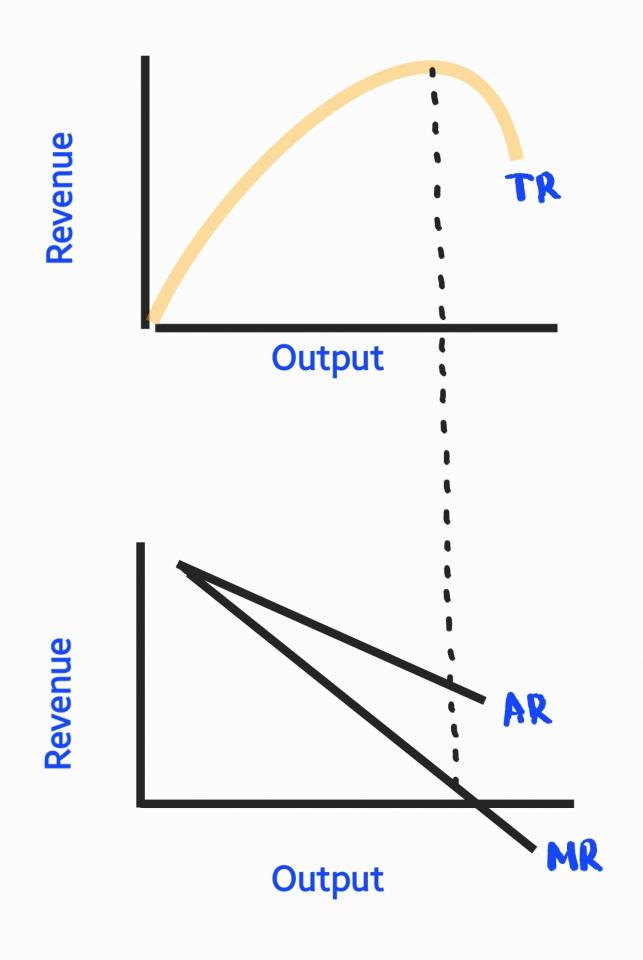
We can see that the total revenue curve begins to fall right when the MR curve becomes negative. The total revenue is maximum when the marginal revenue is zero.
Beyond this point, the firm will not earn additional revenue by selling more units. Furthermore, the average revenue curve cannot be negative (because it is impossible to charge a negative price for the product!).
Market equilibrium and determination of prices
I mentioned we would be studying price determination under different market scenarios. But, before that, let us give a general price determination overview. By now, you know that the price of a commodity is affected by demand and supply.

Have you ever gone to your local grocery store or an e-commerce website and been frustrated because your favorite item is “out of stock”? Or, have you started a business but were left with a lot of unsold stock?
We constantly come across demand-supply imbalances. Market equilibrium is when all demand is met, and all stock is sold. There is parity between demand and supply.
The figure below illustrates market equilibrium.
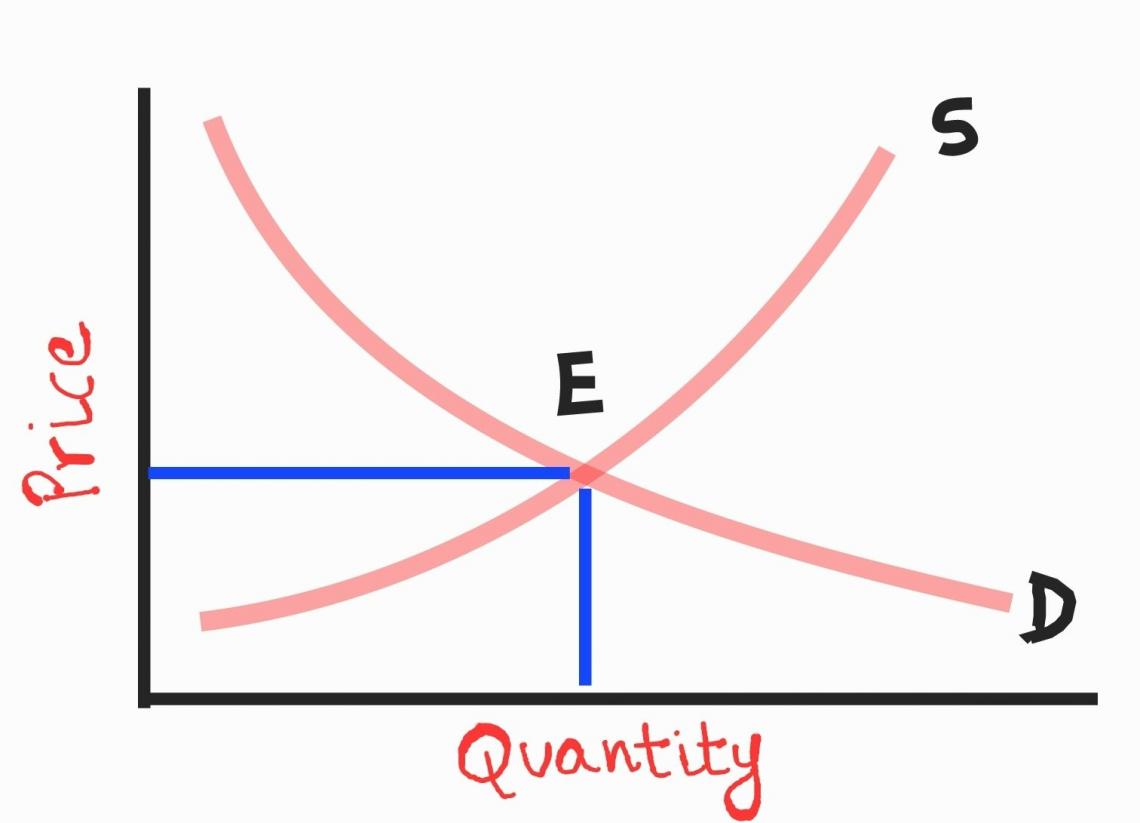
At point E, the market achieves equilibrium. This is the point at which demand equals supply. Notice that supply (S) keeps increasing as price increases, and demand (D) keeps declining.
The firm would want to reduce the supply of commodities whose prices are falling as such commodities are deemed unprofitable. But, at the same time, customers would like to purchase more of these commodities to take advantage of reduced prices.
Therefore, below point “E,” demand is more than supply. Since many buyers cannot procure what they desire, they are willing to pay more to satisfy their needs. Therefore, we know that an increase in price causes an increase in supply.
Therefore, production increases, demand is met, and equilibrium is restored.

Above point “E,” supply is more than demand. Producers are left with a lot of unsold stock. To increase sales, they reduce prices. A price reduction will increase demand and restore equilibrium.
Now that we’ve covered these concepts, let us explore the different market structures and how they operate.

Everything You Need To Master Financial Modeling
To Help You Thrive in the Most Prestigious Jobs on Wall Street.
To understand perfect competition, let us take two situations you might experience. First, you walk into a car dealership to buy your first car. The approach would be to thoroughly examine all the different brands and models and shortlist the best ones.
Once you’ve selected your vehicle, you begin price negotiations with the salesman. If you’re uncomfortable with the price offered, you could walk away and approach another dealership.

Do you do the same while you purchase groceries? No. This is because you know that market prices for items such as milk, eggs, and bread are standardized in your area. Therefore, you would only negotiate a little.
This differentiator is what constitutes perfect competition. However, there are some features unique to this market structure.
- The products you see on the shelves are homogeneous, i.e., hardly any differentiating factor. However, in the case of a car, companies could use many elements, such as design, performance, etc., to gain a competitive advantage.
- No single buyer or seller has complete control over the market. The number of players is so large that a single entity cannot influence the operation of the entire market.
- There is absolutely no room for a price war. This is because there is no price leader. Furthermore, because of homogeneity in products, buyers can switch to a competitor’s product if they are unsatisfied with the price.
- Since no single entity controls the market, it naturally follows that no firm can place entry barriers over the market. Players are free to enter and exit as they desire.
Now that we know what perfect competition means, let us look at the price determination scenario under perfect competition.
Price determination in a perfectly competitive market
We can explore the idea of price determination under any market structure from two spectrums - the firm’s and the industry’s equilibrium.
In the previous section, we discussed the equilibrium of the industry, which is achieved when demand equals supply.
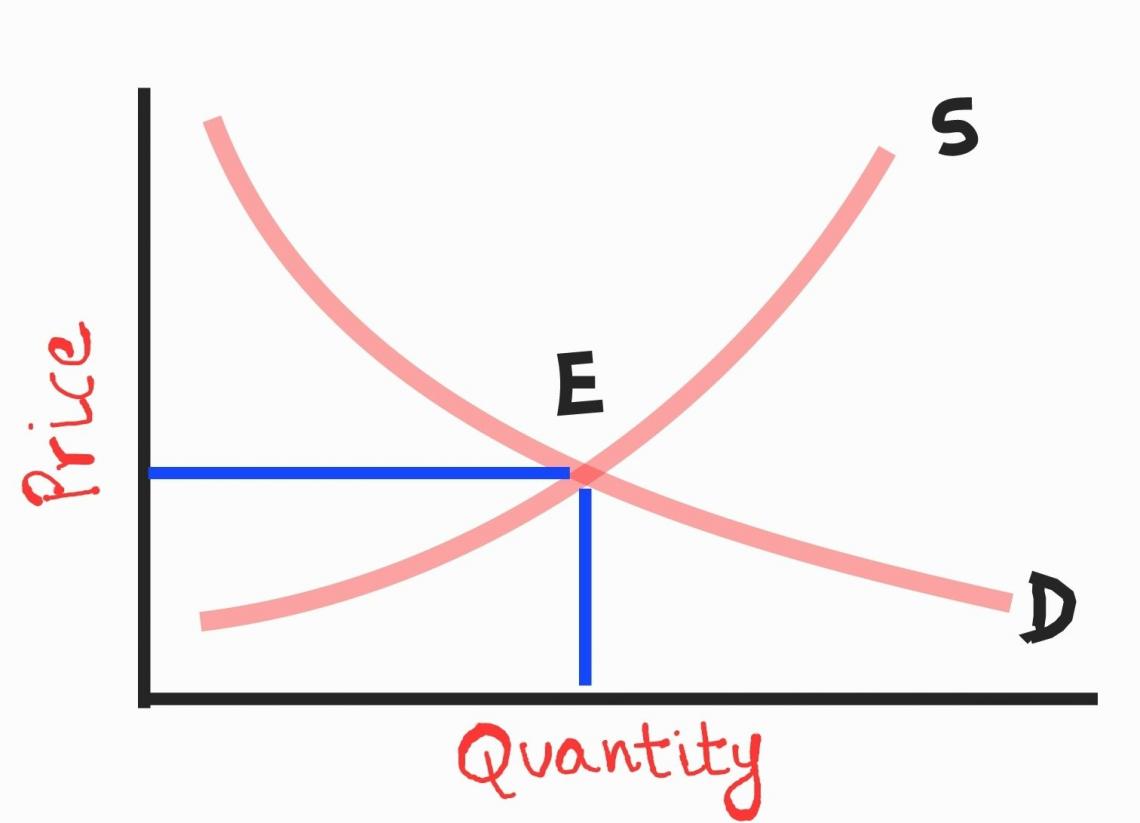
Determining the equilibrium of a firm is a slightly different ball game. The firm’s equilibrium is the point at which it has maximized its profit. Notice that I used the term “profit” and not “revenue.” We need to account for costs too.
We know that businesses in a perfectly competitive market cannot be price leaders. They need to sell their products at a price determined by the market, i.e., the equilibrium price. At this price, they can sell any number of units.
If they sell above the equilibrium price, they will lose customers. But, on the other hand, it does not make sense to operate below the equilibrium price as the firm will lose revenue.
Take a hypothetical example of a firm that sells bread. The market price for bread is $5 per kg. This is the equilibrium price, i.e., the price at which all firms have to sell bread.
We can map an output-revenue chart for this firm under different output conditions.
Notice that the average and marginal revenue remain constant irrespective of output and are equal to the price. Observe the figure below.
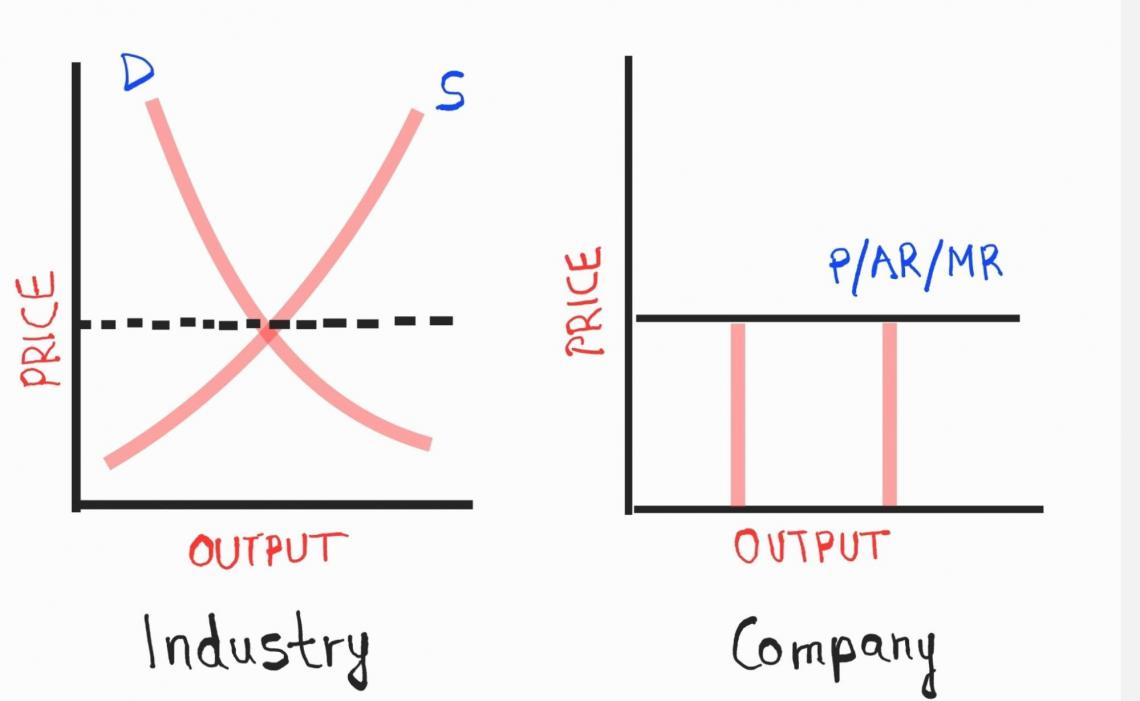
We can see that the price determined by the industry is the price followed by individual businesses. This is because the price/AR curve/MR curve is also the firm’s demand curve. The demand curve happens to be perfectly inelastic.
This means that the demand will be unaffected by a change in price, and the firm can sell any number of units it wishes to.
For a moment, let us talk about marginal cost. First, the marginal cost keeps declining as the firm generates more output due to economies of scale. Then, after a point, the marginal cost begins to increase due to diseconomies of scale.
As we proceed, you will understand why I spoke about marginal cost. A company in a perfectly competitive market must satisfy two conditions to achieve equilibrium.
- The marginal revenue must equal the marginal cost. If MR>MC, the firm must produce more. If MR<MC, the firm is incurring losses and must stop production.
- We can see from the figure below that MR = MC at two points. The equilibrium point is the point at which MC cuts MR and begins to rise.
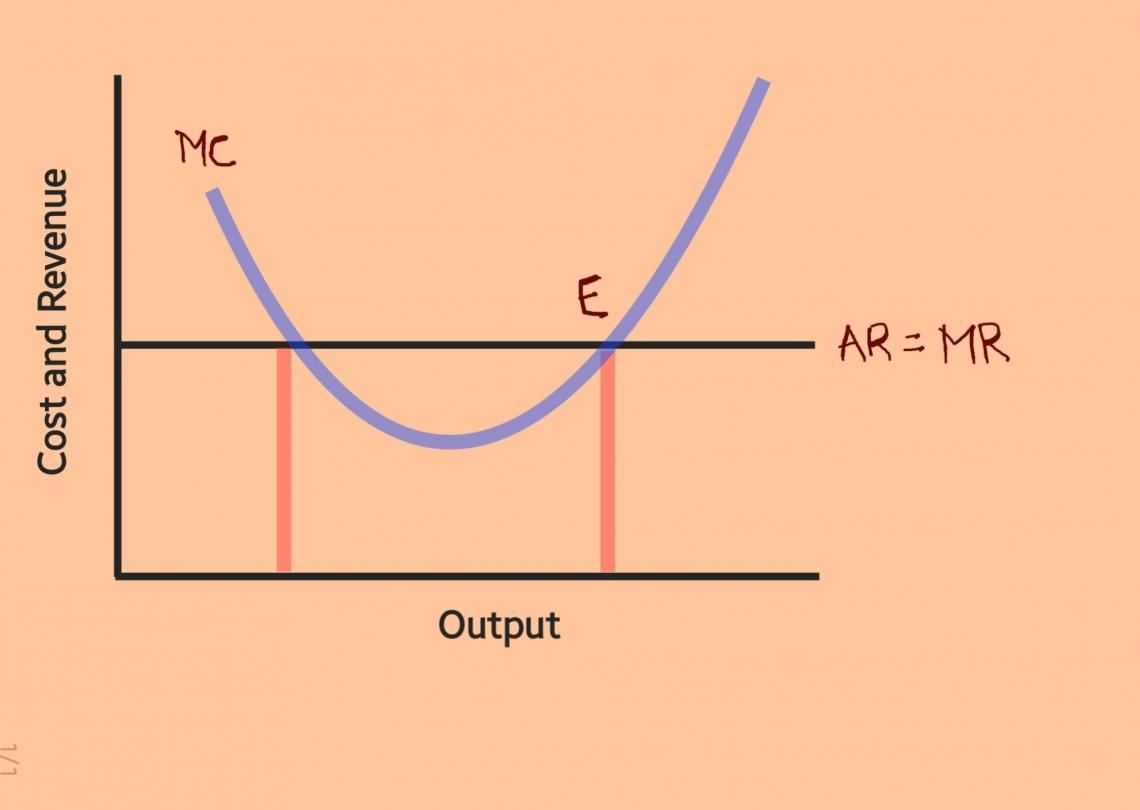
At the first output point, MC = MR, but since the cost is falling, the firm must produce more. If the firm goes beyond point “E,” it will incur losses since the cost rises. Point “E” is the point at which the firm attains equilibrium.
This is a market structure that we would rarely come across today. It is a market where a single seller has complete control over the product. As a result, no other player sells the product, or the sales of the other players are insignificant.
In short, the seller with the largest market share is the king.

Like a perfectly competitive market, a monopoly has a few distinguishable features.
- Only one entity controls the supply of the product. What does this mean? Do you remember how we said that perfectly competitive firms follow the industry and do not have any individual power? In a monopoly, since all control is with one entity, there is no difference between a firm and an industry.
- The firm that controls the market does so because it has established strong barriers which other firms cannot penetrate. We will explore what these entry barriers are in just a moment.
- While perfectly competitive firms accept the market’s price, monopolistic firms are free to adjust their prices.
Let us now explore ways businesses create a strategic advantage that leads to a monopoly.

- Some monopolies have access to precious resources. These resources are in short supply, and having control over such resources enables these firms to control market supply.
- It is not necessary that the firm artificially create entry barriers. Businesses that have improved their production activities and expanded their operations benefit from economies of scale.
- At times, the product or service in question may be hazardous. As such, there might be legal restrictions against mass production, and the authorities assign a single entity complete control.
- A group of businesses may form a conglomerate and use their resources to prevent further competition. New entrants would find it difficult to establish a business in such an environment.
- Some businesses have been in the market for so long that they continue to enjoy complete control solely due to their goodwill over the years.
Price determination in a monopoly market
In a monopoly market, there is no distinction between the business and the industry. Since one entity controls the market, we can map its demand curve exactly how we do so for an industry.
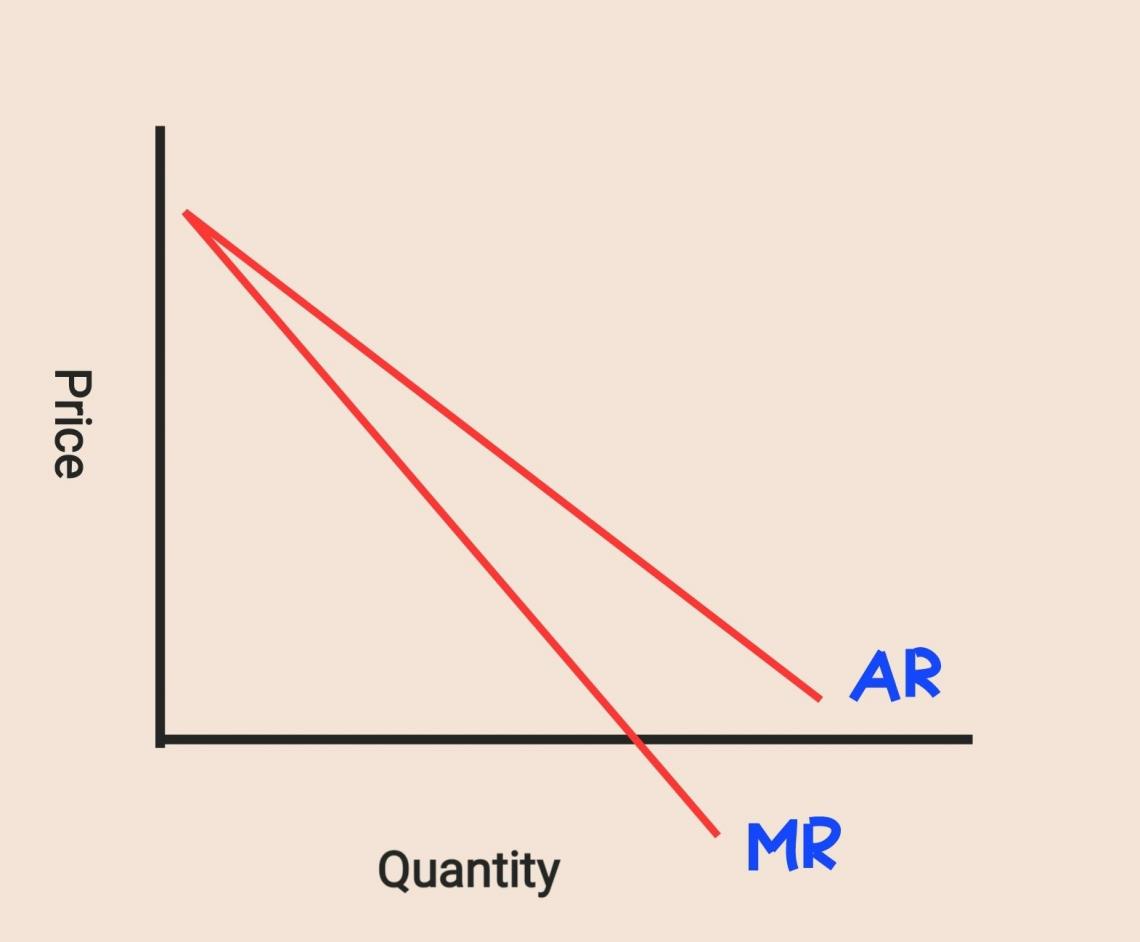
At different price points, the monopolist firm will see different demand levels. The price charged is the average revenue, i.e., the revenue per unit. Therefore, we can say that the average revenue curve represents the price and demand curve.
Although a monopolist enjoys complete control, he cannot charge any price he wishes. Often, regulators cap the price he can charge. But even if there are no restrictions on price, customers will not be willing to purchase beyond a price point.
Therefore, a firm in a monopoly market faces a downward-sloping demand curve.
How does a firm in a monopoly attain equilibrium? Perfectly competitive firms accept the market price. They do not have any restrictions on production and can sell any units at the market price.
In a monopolistic market, the seller must reduce the price to increase sales as the demand curve slopes downward. To attain equilibrium, the monopolist must find the combination of price and output that maximizes profits.

The equilibrium conditions for a monopolistic firm are similar to those of a perfectly competitive firm.
The average cost and marginal cost curves are similar across all market structures. The marginal cost curve initially declines due to economies of scale but later rises due to diseconomies of scale.
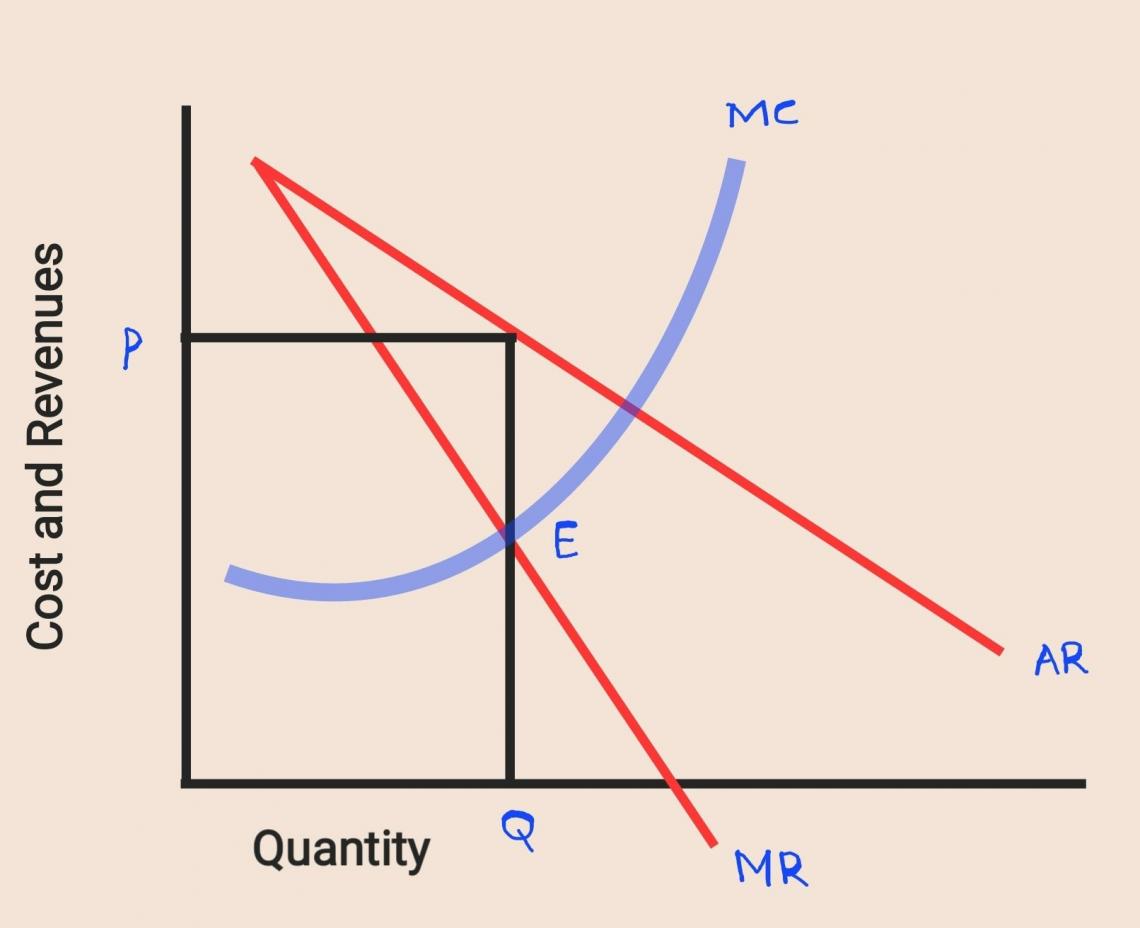
First, the marginal revenue curve intersects the marginal cost curve at point “E.” This is the profit maximization point. Second, “EQ” is the equilibrium quantity. Finally, we get the equilibrium price when we extend this point to the demand curve.

Everything You Need To Master Algo Trading using Python
To Help You Thrive in One of the Most Future Proof Careers on Wall Street.
Let us journey back to the concept of perfect competition. First, we learned that since all the products are homogeneous, the buyer can switch to a competitor’s offering. But, realistically, perfect competition is only a theoretical concept.
Take the example of milk. On the surface, it seems that milk is a homogeneous product. After all, how much can you differentiate milk?
However, businesses have developed many innovative offerings to differentiate themselves from their competitors. Such competition has led to the production of skim milk, organic milk, lactose-free milk, raw milk, and tons of other variants.

Price wars are seldom healthy. While businesses in a perfectly competitive market engage in price wars, a monopolistic competition environment is one where sellers attempt to make their products stand out.
This differentiating factor is why the market structure has been termed “monopolistic” competition. It is an amalgamation of both perfect competition and monopoly.
Let us look at some of the features of monopolistic competition.
- A perfectly competitive firm’s demand curve is elastic because the products are perfect substitutes. However, products in monopolistic competition are close substitutes, i.e., they have differentiating factors.
- Like the perfect competition, there are hardly any barriers to entry and exit. New players come and go as they please.
- The firm gains a competitive advantage through innovation rather than price wars.
Price determination under monopolistic competition
We established that monopolistic competition shows a relatively elastic demand curve because of product differentiation and close substitutes.
The demand curve’s steepness measures the demand elasticity: the flatter the curve, the more elastic the demand.
The elasticity of demand measures the magnitude of change in demand due to a price change. The more elastic the demand, the more the market responds to a change in price.
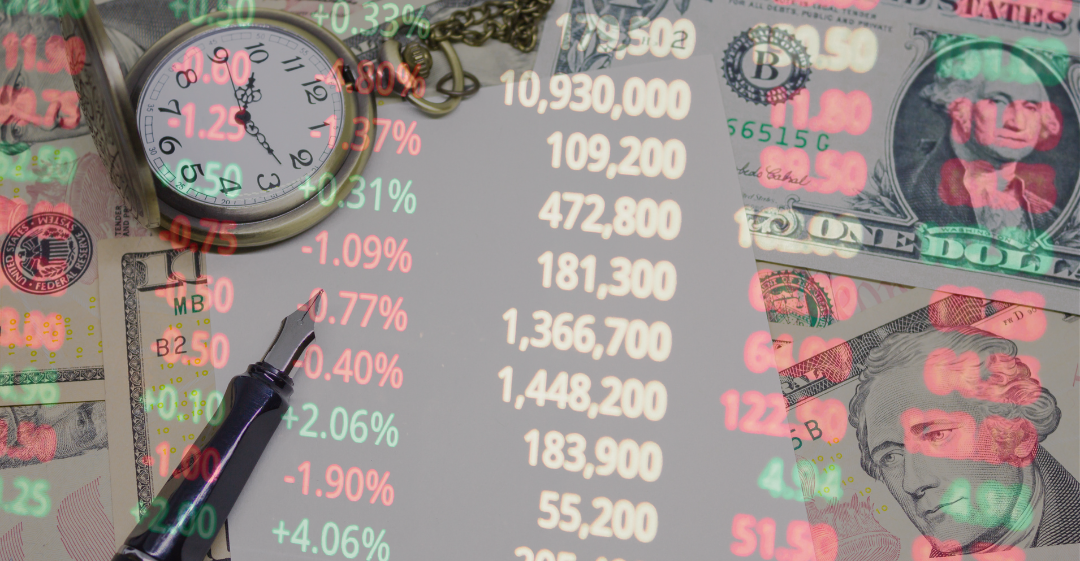
In a monopolistic competition scenario, the degree of differentiation will determine the elasticity of demand. Therefore, the more the product is differentiated, the greater the competitive advantage and the steeper the demand curve.
It is important to note that firms under monopolistic competition cannot earn supernormal profits . Normal profit is a scenario where revenues are only sufficient to meet costs.
The reasoning is that many other firms would want to enter the industry if businesses generate revenues over and above their costs. Due to increasing competition, profits begin to fall, and the firm earns a normal profit.
Conversely, if enterprises incur losses, many players exit, and the market returns to earning normal profits.
The equilibrium of a firm in monopolistic competition is achieved by maximizing profits. Yet again, the conditions for equilibrium are the same as seen in the previous market structures.
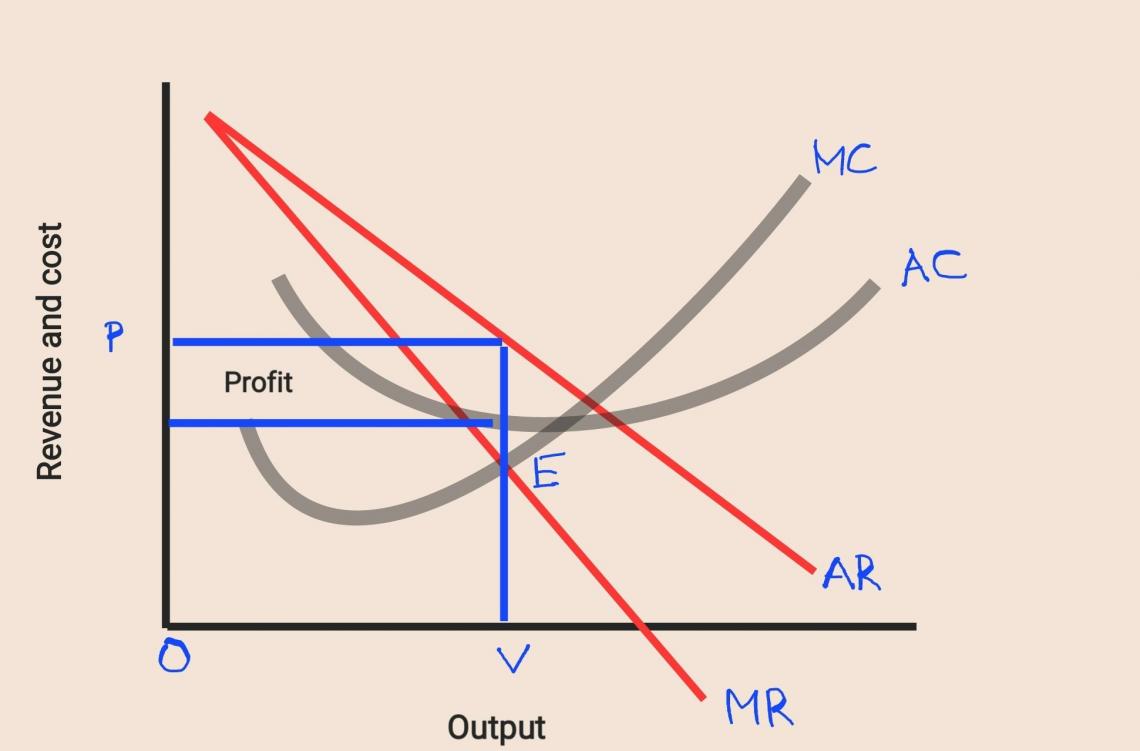
We can see that the equilibrium point, i.e., the point at which the MR curve cuts the MC curve, is “E.” EV is the target output, and OP is the target price at which the firm operates.
Notice that the profit, i.e., the area from point “P” to point “E,” is the difference between the average revenue and average cost.
Remember how we said the marginal revenue curve is bound to fall and rise faster than the average revenue curve? This is because a change in the cost of producing one unit is more significant than the change in total per unit cost.
Therefore, when the cost curves are falling ( due to economies of scale ), the marginal cost curve falls faster and is below the average cost curve. Conversely, when the cost curves increase, the MC curve lies above the AC curve.
Let us explore the final market structure, i.e., oligopoly. An oligopoly is a more realistic market structure. We could describe oligopoly as a variation of monopoly.
In monopoly, we saw how a few market leaders firms form a conglomerate to create entry barriers for new entrants. Such a congregation is known as an oligopoly.

The oligopolistic approach has a few features. These are discussed below.
- There are very few firms that collectively control the market. These firms create entry barriers on the strength of their market share .
- Unlike perfect competition, where no individual firm can affect the market’s performance, each player in an oligopoly can exercise influence over the market. Any move by one business will face similar retaliation from all other businesses.
- Like under monopolistic competition, players in an oligopoly actively avoid price wars. They compete through product differentiation and innovative ventures.
- Usually, firms that form a conglomerate appoint a leader. This leader guides the group’s actions and helps provide an operational framework. All businesses draft their policies by considering the movements of the leader.
We will conclude by looking at the price determination and equilibrium scenario under an oligopolistic market .
Price determination in an oligopolistic market
It is neither possible nor feasible for businesses in an oligopolistic environment to engage in price wars. As soon as competitors notice that a rival firm has altered its prices, they would also bring their prices down.

A unique feature of oligopoly is that it is challenging to create a demand curve for an individual firm because of rival responses. However, many strategies have been developed for price determination through experiential learning.
As discussed, one of the most common approaches is appointing a price leader. The price leader looks at industry trends and determines a price-output range to maximize profits. The other firms simply follow.

Sometimes, the businesses jointly agree to work in tandem and form an organization that serves the interests of all its members. As a result, all benefits arising from the conglomeration are shared equally or as agreed.
The most common example of such a conglomeration is the Organization of the Petroleum Exporting Countries (OPEC) .
The final approach is to ignore the collusion and act as independent entities completely. Each firm is responsible for its costs, profits, and losses. We can then draw up a demand curve for each firm.
Paul M. Sweezy developed a theory depicting an oligopolistic firm’s demand curve. He opined that the demand curve of an oligopolistic firm is kinked, as shown below.
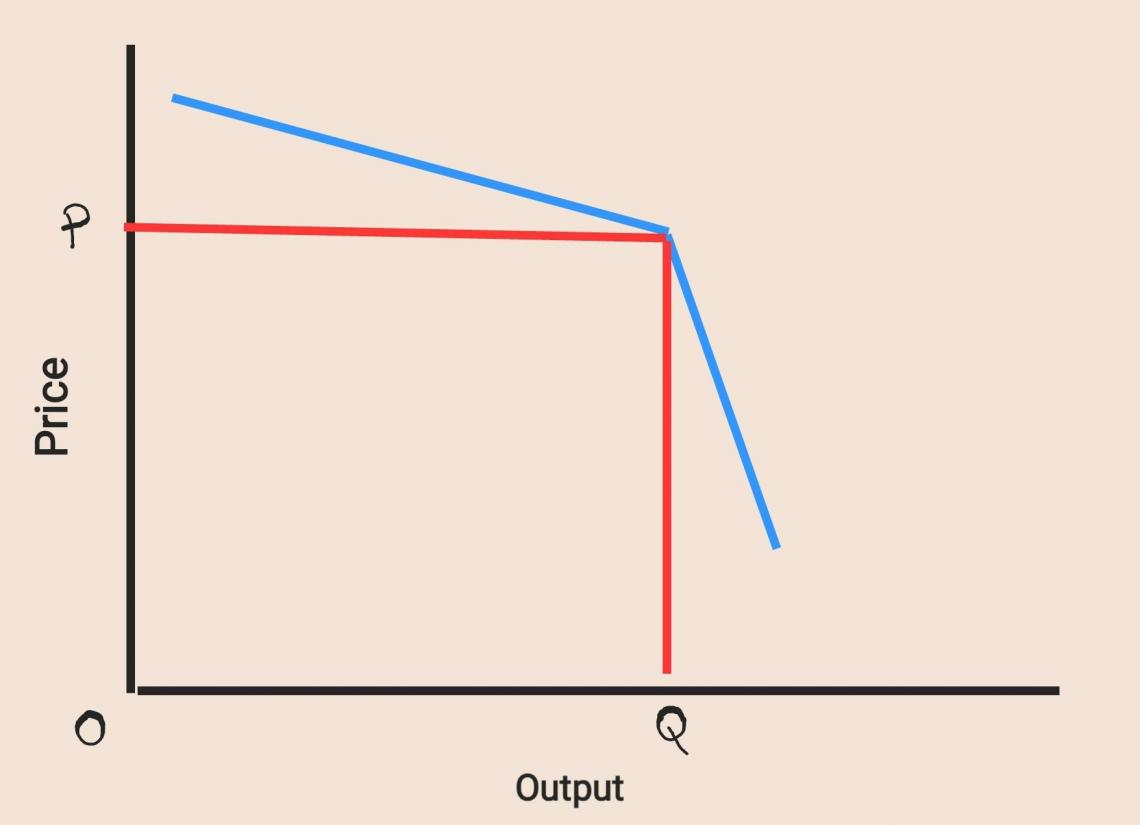
Notice that the demand curve becomes steeper after a point. This price point is the price that is predominant in the market. Below this point, demand is relatively inelastic, i.e., it does not respond much to price changes.
Key Takeaways
- There are four market structures - Perfect competition, monopoly, monopolistic competition, and oligopoly.
- In a perfectly competitive market, products are homogeneous, there are many sellers, the market determines the price, and each seller can sell as much output as desired at this price.
- A monopoly is a market where only one entity controls the working of the market. He is not a price taker but fixes the market’s price. There is no distinction between the firm and the industry.
- Monopolistic competition is also called imperfect competition. There are many sellers, just as in perfect competition, but competition is based on product differentiation rather than price.
- An oligopoly is a market wherein the major players form a conglomerate. This union is to prevent competition and create entry barriers.

Everything You Need To Master Financial Statement Modeling
To Help you Thrive in the Most Prestigious Jobs on Wall Street.
Researched and authored by Sathyanarayana Sairam | LinkedIn
Reviewed and edited by Parul Gupta | LinkedIn
Free Resources
To continue learning and advancing your career, check out these additional helpful WSO resources:
- Economies of Scale
- Financial Economics
- Macroeconomics

Get instant access to lessons taught by experienced private equity pros and bulge bracket investment bankers including financial statement modeling, DCF, M&A, LBO, Comps and Excel Modeling.
or Want to Sign up with your social account?
Economic Analysis of Market Structure

Checked : Grayson N. , Curtis H.
Latest Update 21 Jan, 2024
12 min read
Table of content
Market structure
The features of a market structure, perfect competition, contestable market.
Major economic activities that lead to growth and development are defined by the strength of the markets that operate within it. This is because markets have the biggest role to play in these economies. When a single firm makes a decision, it may not have much impact on the general economy. But when many companies within a market setup make a decision, for instance, to stop production, the whole market faces the impact, which extends to the whole economy.
Consider the events that led to the 2008-2009 financial crisis, for instance. The US economy has been booming over several years before this event. Therefore, the economic bubble seemed like a good idea for investors to take loans and take their investments to other levels, especially in the housing industry. Financial institutions were so confident in their clients that they flexed the requirements for taking loans. Many of them did not do a proper background check to ascertain borrowers' ability to repay the loans. The economy was at its peak, and many indicators showed it would continue on an upward scale for another long period. Until the worst happened and house prices dropped significantly. The banks that had taken these properties as collateral were unable to sell them, let alone give out at a price that would help recover the lent money.
And this was the beginning of trouble for many financial institutions. With things getting worse by the day, some failed to recover completely, which forced them to announce a state of bankruptcy. Financial markets were the worse hit by the situation, and even when some monetary policies were applied to salvage the economy, many of them were unable to recover. This was defined as the worse economic crisis faced within financial markets.
As we already know, financial markets are among the biggest contributors to the general economy. For instance, many banks in the developing world lend money to small scale businesses, helping them pick up the pace and grow at a pace they would not have expected. It is also the financial markets that determine how much money is given into the economy or how much is withdrawn. When interest rates go high, the financial markets are there to ensure borrowers are taking money they can pay back, and when the rates go down, the same markets give out money at a controlled rate to ensure everything flows smoothly.
Economic growth and development have been relying a lot on the events taking place within financial markets. And when we talk about financial markets, we are referring to all financial intermediaries and money lending institutions, including insurance companies, which play a crucial role in any given economy.
When the financial markets fell, the effect spread fast into other sectors of the world economy. It became hard to import and export different products as inflation rates rose, leading to higher or lower r exchange rates went through the roof. Businesses that relied on borrowed resources from banks were unable to access these resources, making some to close some branches. And those that defaulted in their loans were forced to sell off some of their assets to cover their premiums. Households went into a state of panic and started withdrawing money from banks at a high rate. Since some of the banks had already shown signs of struggle, these mass withdrawals further crippled the operations, making it even hard to recover.
When reports came about the crisis, the main headlines talked about an economic crisis and not much about banks' falling. In other words, the fall of these markets was viewed from their effects on the general economy. When governments came up with fiscal and monetary policies to salvage the situation, they also talked about saving the economy, even though many steps were towards rescuing major financial intermediaries.
This shows just how important markets are in economies. They begin with firms operating under similar rules, or selling the same type of products, growing into a large community of firms. But that is not all. In the market, there must be producers and consumers. In any case, consumers are the households who are the final users of these products. The relationship between these two players creates the perfection of the market.
All markets are structured in a specific way, with laws and policies that guide firms' operations with the system. The best way to define market structure is, it's the organizational and other characteristics of a market. There are different features that make markets unique of similar, mostly depending on the goods and services linked to that market. When a company wants to enter or exit a market, they have to follow a specific set of guiding rules that tell them what to do. Companies don't just operate as they want in any market. For instance, when it comes to setting prices, come markets are defined as price givers, and others as price takers. It is all about the organizational features of those markets.
Consider financial markets, for instance. It is the Central Banks that determine how much money a bank can hold at any given time, and they also determine the interest rates to be charged on borrowed money. In this case, Central Banks become the regulatory body that sets the standards for operating in financial markets. When the economy is booming, they raise interest rates to discourage excessive borrowing and shield banks from the aftermath. And when the economy is low, interest rates are reduced to encourage borrowing.
There is only an example of what market structure is, and an idea of what happens within them. There are many other characteristics that make up proper market structures. But the main ones concern features that affect the nature of competition and pricing. Many people put too much emphasis simply on the market share of the existing firms in an industry – which is also a good approach to market structure, but there is a lot more than needs to be carefully considered.
Traditionally, important features of a market structure include:
- The number of companies. As stated above, we are looking at market structure in terms of competition and pricing. In this case, a complete market is expected to carry a specific number of firms, including the scale and extent of foreign competition. As more companies join a market, the competition level increases, making it even easier to describe the market. But this also means increased competition, which affects even the pricing models.
- The markets share of the largest companies. In a perfect market, each firm operates on the same level, and there is no big or small. But such markets are only theoretical. Imperfect competition is major in many economies, especially developed ones. Hence, market structures are defined by these firms' market capitalization, who are also the main decision-makers. This is measured mainly by the concentration ratio – that is, how popular the firms' products are with different consumers.
- The nature of costs. The cost of production is among the main determining factors for pricing, and essentially the company's growth. In this case, the costs include the potential for firms to exploit economies of scale and also the presence of sunk costs that affect the contestability of markets in the long run.
- The extent to which the industry is integrated vertically. Vertical integration is the main feature for explaining the process by which different stages in production and distribution of a product are under ownership and control of one enterprise. One example of such integration is the oil markets in which large firms own the rights to extract from oil fields. They also run a fleet of tankers, operate refineries, and control the sales at their own filling stations. In such a case, it is very hard for new firms to join the industry since a few have already taken control of everything.
- Product differentiation degree. Even though some firms may be producing the same products, they come with different degrees of difference, which affect cross-price elasticity of demand. For instance, some manufactures may be making low-quality products, whereas others only make the highest quality.
- The structure of buyers in a market. It most industries, buyers are structured in different forms. For instance, a buyer will make more informed decisions if they have all the information they need about the manufacturer and the general industry. This is where the aspect of the brand loyalty comes in.
- The turnover buyers. This feature is also called 'market churn,' and it means how many product users are ready to switch their supplier over a specific period where there is a change in the market conditions. The degree of customer turnover is determined by the extent of consumer or brand loyalty. It is also impacted by the influence of persuasive advertising and the market. Many loyal customers will find it very hard to change unless the firm stops advertising, and the competition becomes very aggressive in this.
The type of competition in them defines market structures. And there are four main characteristics that determine these structures. They include:
A perfect competition market is one that has many firms selling homogenous products. The firms are price takers since price competition does not exist. There is no big or small company, and there is not a better or worse product. All consumers have perfect information about the products, and they will buy with a proper understanding of what they need.
Also, firms gain supernormal short-run profit but not supernormal long-run profit. All conditions are favorable for the joining and exit of other firms. In perfect competition, firms do not set prices since they don't have much control over this and their customers' consumption needs.
The best thing about the type of markets is that firms don't have to worry about too much marketing. Consumers already know the products, and the market is open for anyone who wishes to join. There are no barriers to entry. Most importantly, such industries are defined by high-economic output.
Perfect competition is, however, only in the books. We live in a world of imperfect information, which creates imperfect competition. Firms with access to more information are less willing to share, applying it only to the advantage.

We Will Write an Essay for You Quickly
This is another feature of market structure that defines an industry with few dominant firms. The products are differentiated, and there are many barriers to entry. Firms are established to gain supernormal short-term and long-run profits.
The firms are price makers, though they feature independent behavior. Non-price competition is very crucial in these markets, and the economic value is low allocative. These markets are the most common in modern economies.
A monopoly, as the name suggests, is a market that has one firm with pure monopoly. An effective duopoly is also common in many cases. Product type is limited since there is only one firm producing and supply the goods. Supernormal short-run and long-run profits are very high.
The firms are price makers, though the demand curve and possible regulations constrain them. There is a non-price competition, though not as important as in oligopoly markets.
These are markets that also have many firms. The products are differentiated, and there are low entry and exit barriers. They gain any profit possible in terms of supernormal short-run and long-run profits. The pricing power fall with the firms, who are the price maker – though the real power and potential competition limit pricing power. Non-pricing competition is very important in these markets.
In economics, markets are categorized based on the structure of the industry serving the market. On the other hand, the industry structure is categorized based on market variables that, many believed, determine how far the characteristics of competition go.
The four market structures explained above from an abstract (generic) in the characterization of a type of I real industry. Market structure affects the outcomes of that market due to its impact on the motivations, opportunities, and economic actors' decisions taking part in the market. Economic market structure analysis aims at setting apart these effects as they try to explain and predict market outcomes.
Looking for a Skilled Essay Writer?

- University of Nottigharm Bachelor of Applied Science
No reviews yet, be the first to write your comment
Write your review
Thanks for review.
It will be published after moderation
Latest News

What happens in the brain when learning?
10 min read
20 Jan, 2024

How Relativism Promotes Pluralism and Tolerance

Everything you need to know about short-term memory
Live revision! Join us for our free exam revision livestreams Watch now →
Reference Library
Collections
- See what's new
- All Resources
- Student Resources
- Assessment Resources
- Teaching Resources
- CPD Courses
- Livestreams
Study notes, videos, interactive activities and more!
Economics news, insights and enrichment
Currated collections of free resources
Browse resources by topic
- All Economics Resources
Resource Selections
Currated lists of resources
A2 Micro: Market Structure, Conduct & Performance

19th May 2011
- Share on Facebook
- Share on Twitter
- Share by Email
This updated revision presentation is designed to help students preparing for markets-related topics on A2 economics specifications.
Market Structure Conduct & Performance - revision presentation
Download printable (pdf) slide handout
Market structure is best defined as the organisational and other characteristics of a market. We focus on those characteristics which affect the nature of competition and pricing – but it is important not to place too much emphasis simply on the market share of the existing firms in an industry.
Traditionally, the most important features of market structure are:
*The number of firms (including the scale and extent of foreign competition) *The market share of the largest firms (measured by the concentration ratio – see below) *The nature of costs (including the potential for firms to exploit economies of scale and also the presence of sunk costs which affects market contestability in the long term) *The degree to which the industry is vertically integrated - vertical integration explains the process by which different stages in production and distribution of a product are under the ownership and control of a single enterprise. A good example of vertical integration is the oil industry, where the major oil companies own the rights to extract from oilfields, they run a fleet of tankers, operate refineries and have control of sales at their own filling stations. *The extent of product differentiation (which affects cross-price elasticity of demand) *The structure of buyers in the industry (including the possibility of monopsony power) *The turnover of customers (sometimes known as “market churn”) – i.e. how many customers are prepared to switch their supplier over a given time period when market conditions change. The rate of customer churn is affected by the degree of consumer or brand loyalty and the influence of persuasive advertising and marketing
Market structure and innovation
Which market conditions are optimal for effective and sustained innovation to occur? This is a question that has vexed economists and business academics for many years.
High levels of research and development spending are frequently observed in oligopolistic markets, although this does not always translate itself into a fast pace of innovation.
The work of William Baumol (2002) provides support for oligopoly as market structure best suited for innovative behaviour. Innovation is perceived as being “mandatory” for businesses that need to establish a cost-advantage or a significant lead in product quality over their rivals
Geoff Riley
Geoff Riley FRSA has been teaching Economics for over thirty years. He has over twenty years experience as Head of Economics at leading schools. He writes extensively and is a contributor and presenter on CPD conferences in the UK and overseas.
You might also like
Our subjects.
- › Criminology
- › Economics
- › Geography
- › Health & Social Care
- › Psychology
- › Sociology
- › Teaching & learning resources
- › Student revision workshops
- › Online student courses
- › CPD for teachers
- › Livestreams
- › Teaching jobs
Boston House, 214 High Street, Boston Spa, West Yorkshire, LS23 6AD Tel: 01937 848885
- › Contact us
- › Terms of use
- › Privacy & cookies
© 2002-2024 Tutor2u Limited. Company Reg no: 04489574. VAT reg no 816865400.
Take 10% OFF— Expires in h m s Use code save10u during checkout.
Chat with us
- Live Chat Talk to a specialist
- Self-service options
- Search FAQs Fast answers, no waiting
- Ultius 101 New client? Click here
- Messenger
International support numbers
For reference only, subject to Terms and Fair Use policies.
- How it Works
Learn more about us
- Future writers
- Explore further
Ultius Blog
Essay on market structure.

Select network
Business competition takes on different forms depending on the type of market structure present in a given industry. This sample essay explores the four primary models of market structure:
- Perfect competition
- Monopolistic competition
Different types of market structure and competition
In the world of economics, the competition between businesses is not always the same or level. Certain fields of industry have very different types of markets than that of others. Where one business could find itself in a field of competition where the playing field is leveled and easy to gain a foothold within, others find themselves in playing fields that are heavily stacked to favor one (or several large) industrial player. The most common forms of market structure that are seen in the economic world are:
All of these market structures have defining characteristics that separate them from each other and are all set up in a way that will have a dramatic distinction on how the competition within that market works. The defining characteristics of the market structure will be one of the most important determining factors in how many, as well as, how large the major players within that particular market become.
One such example of a company that operates efficiently within its particular market structure is Samsung Electronics. By understanding and playing to the strengths of the market structure that the company finds itself within, Samsung Electronics has been able to become one of the largest and most financially successful companies in the business world.
Perfect competition and equilibrium within the market structure
The first market structure to be described is named perfect competition. This market structure is most easily recognized by the fact that its low barriers for entry on both the buyer and seller allow for the continued operation of a large number of firms (Econ Guru, 2006). With a market structure such as this, new firms are able to constantly enter the market so long as they offer a product or service to a consumer base that is well received.
The economic efficiency within the perfect competition market structure, therefore, is seen to be very high because of these low entry barriers for new firms, which allows for a constant and continued level of competition to be maintained by the different number of firms within the particular market (Riley, 2012). One of the benefits of perfect competition is easier access to market segmentation and determining the demographics of the market . One of the most surprising factors about this sort of market structure, however, is seen when examining the innovative behavior of firms within this market.
Upon first glance, one would naturally be inclined to believe that the innovative behavior for a perfect competition market would be very strong because start-up firms would want to bring new, creative ways to market in order to propel their firms into a position of exposure and success. Research shows this hypothesis to be incorrect, though. Instead, the innovative behavior of a perfect competition market is relatively weak.
“In capitalist reality as distinguished from its textbook picture, it is not that kind of competition which counts but the competition which commands a decisive cost or quality advantage and which strikes not at the margins of profits and the outputs of the existing firms but at their foundations and their very lives,” (Riley, 2012).
The old style monopolistic competition market structure
The next type of market structure to be examined is the monopolistic competition market structure.
Within this type of market, one would typically expect to see a large number of firms that produce a “congeneric product with distinguishable differentiations,” (Econ Guru, 2006).
This means that firms within this market structure will have many different competitors within the market, but each competitor will be selling a slightly different type of product. Within this market, the entry barriers for both the buyer and the seller are very low and allow for easy entry or exit from the market (Hubbard & O’Brien). Compare Google Docs and Microsoft Word for example. Both companies offer data and word processing software that have similar but distinctly difference attributes.
One of the distinguishing features for firms within this market structure comes from the pricing found within it. Within a monopolistic competition market, the firms act as the price makers; they can set, raise, and lower the price of their products because they are selling something that is highly individualized (Economics Online).
Because of the set up of this market structure, the level of innovation is considered to be quite strong as firms entering the market can make subtle changes to existing products to form new, unique ones. This market structure, therefore, places a high emphasis on advertising.
Firms that operate within the monopolistic competition market are, “often in fierce competition with other (local) firms offering a similar product or service, and may need to advertise on a local basis, to let customers know their differences, ” (Economics Online).
Studying high-level marketing? Consider using Ultius for your thesis needs .
Monopoly's role within a structured economy
A third market structure seen in the economic world is the monopoly. The monopoly is characterized as a market in which there is only one provider for a good or service to consumers (Econ Guru). Within this type of market structure, the barriers for entry are extremely high as the firm with all of the power in the market can undercut its prices and force competitors out of the market. The United States started to abolish monopolies within the nation during the 1890's with the enactment of the Sherman Antitrust Act .
From a buyer’s perspective, the barriers are low as their selection for products or services is so limited. In a pure monopoly with only one firm controlling the market, the type of product is very limited; in fact, it is exclusively limited to what that particular firm offers to its consumers (Riley, 2012).
Being the controlling power of the market, a firm operating within a monopoly is considered to be a price maker in that it will be able to continually set, raise, and lower the cost of its offered product or service. Within this type of market structure, the economic efficiency does run the risk of being damaged as the controlling firm will not have to deal with any competition, which could allow for the firm to become inefficient over time (Riley, 2012).
The same holds true for the innovative behavior within a monopolistic market. The controlling firm has no real reason to be constantly reimagining and redesigning its products or services and can instead release upgrades and updates at its own pace with no real urgency. Although, it is worth noting that a firm that holds a monopoly on the market could also have a strong innovative behavior because it is able to spend a great deal of its profits on research and development.

Oligopolies and corporations' efforts to control the market
The final market structure to observe is the oligopoly. Similar to a monopoly in many regards, the oligopoly has one major difference when compared to the former. Within a monopoly, there is one firm that controls the market, whereas an oligopoly has a few firms that dominate the market (Econ Guru, 2006). A market structure such as this will place considerable barriers on new firms that are entering the market as they must compete with several corporate giants, but will put limited barriers on the buyer because of the different options available to him or her.
The firms that dominate the market of an oligopoly can act, for the greater part, as price makers so long as the dominant firms keep their prices relatively similar (Riley, 2012). One such example of this occurring in the real world is seen in the gas industry. The large firms that control the industry are able to set the price for gasoline to whatever they should choose so long as the competition does not dramatically lower their own prices and attract a larger proportion of the market to utilize its product exclusively. It is within this market that the innovative behavior is observed to be the highest (Riley, 2012).
The dominant firms are seen to spend a significant portion of their marketing resources on research and development so that they can have the most innovative products to offer to their consumer base in order to attempt to gain a larger control of the market and gain a competitive advantage over their major competitors. It is this sort of market structure that Samsung Electronics finds itself a part of.
Samsung Electronics operates in a market that is clearly an oligopoly. One of the major components to this firm is seen in its cellular phone sales. In this market, Samsung operates as a dominant force along with such companies as Apple, Motorola, and LG. Outside of these major players, the competition is much more limited.
It is extremely difficult for outside firms to gain a foothold in this market because the dominant firms have such a large percentage control of the consumer base currently. The effectiveness of the market structure is extremely beneficial for Samsung, and they have taken full advantage of it to become one of the most dominant firms in their particular market. It is directly from the structure of the market that the forms of labor and demand are shaped for Samsung.
Samsung and the oligopoly
The demand that Samsung receives is based almost entirely as a consequence of the market structure of an oligopoly. Because Samsung created a business strategy that is able to dominate the market and place a high emphasis on the research and development of new, innovative products, the firm is able to offer technologically superior products to its consumer base that allows for the demand for its products to rise.
The Galaxy S III is a perfect example of this. This particular product is so innovative and well designed that it has allowed Samsung to become one of the top sellers of mobile phones worldwide and has consistently beaten out the iPhone 5 (Samsung’s main competition from Apple) on a consistent basis. In terms of labor, as well as supply, the same basic principle holds true.
It is because of the dominant share of the market that Samsung controls by successfully navigating its market structure that allows for the company to produce so many products and keep its supply high enough to meet the demand facing it, and in order to produce such a high supply of new, innovative products, Samsung is able to employ a large labor force for everything from assembly of a product to research and development of new ways to design, market, and ultimately sell to its consumer base.
Market structures play a key role in the way a firm is able to do business. By understanding what sort of market structure that a firm is placed in, that firm will be able to see if the cost of business is worth continuing to fight for. The factors that separate the different types of market structures can be the difference in whether or not a start-up firm will be able to become successful or be driven from business by the major players that currently exist in that particular market structure.
It is by understanding and playing to the market structure that certain companies such as Samsung Electronics have been able to become so successful. Different market structures place emphasis on different factors; however, one truth is held. In the end, every firm is simply trying to push its products or services onto its consumer base. This is one of many economic axioms that has come about as a result of study and research paper writing .
Econ Guru. (2006). Market structure. EconGuru Economics Guide, Retrieved from http://www.econguru.com/micro/market-structure.shtml
Economics Online. (2012). Monopolistic competition. Economics Online, Retrieved from http://www.economicsonline.co.uk/Business_economics/Monopolistic_competition.html
Hubbard, R. G., & O'Brien, (2012). Economics. (4th ed.). Prentice Hall.
Riley, G. (2012, September 23). Market structure summary. Tutor2u, Retrieved from http://www.tutor2u.net/economics/revision-notes/a2-micro-market-structures-summary.html
https://www.ultius.com/ultius-blog/entry/essay-on-market-structure.html
- Chicago Style
Ultius, Inc. "Essay on Market Structure." Ultius | Custom Writing and Editing Services. Ultius Blog, 06 Dec. 2013. https://www.ultius.com/ultius-blog/entry/essay-on-market-structure.html
Copied to clipboard
Click here for more help with MLA citations.
Ultius, Inc. (2013, December 06). Essay on Market Structure. Retrieved from Ultius | Custom Writing and Editing Services, https://www.ultius.com/ultius-blog/entry/essay-on-market-structure.html
Click here for more help with APA citations.
Ultius, Inc. "Essay on Market Structure." Ultius | Custom Writing and Editing Services. December 06, 2013 https://www.ultius.com/ultius-blog/entry/essay-on-market-structure.html.
Click here for more help with CMS citations.
Click here for more help with Turabian citations.
Ultius is the trusted provider of content solutions and matches customers with highly qualified writers for sample writing, academic editing, and business writing.

Tested Daily
Click to Verify
About The Author
This post was written by Ultius.

- Writer Options
- Custom Writing
- Business Documents
- Support Desk
- +1-800-405-2972
- Submit bug report
- A+ BBB Rating!
Ultius is the trusted provider of content solutions for consumers around the world. Connect with great American writers and get 24/7 support.
© 2024 Ultius, Inc.
- Refund & Cancellation Policy
Free Money For College!
Yeah. You read that right —We're giving away free scholarship money! Our next drawing will be held soon.
Our next winner will receive over $500 in funds. Funds can be used for tuition, books, housing, and/or other school expenses. Apply today for your chance to win!
* We will never share your email with third party advertisers or send you spam.
** By providing my email address, I am consenting to reasonable communications from Ultius regarding the promotion.
Past winner

- Name Samantha M.
- From Pepperdine University '22
- Studies Psychology
- Won $2,000.00
- Award SEED Scholarship
- Awarded Sep. 5, 2018
Thanks for filling that out.
Check your inbox for an email about the scholarship and how to apply.
Home — Essay Samples — Business — Amazon — Market Structure Analysis – Amazon
Market Structure Analysis – Amazon
- Categories: Amazon
About this sample

Words: 382 |
Published: Jan 29, 2024
Words: 382 | Page: 1 | 2 min read
Table of contents
Overview of amazon's market structure, dominance of amazon in the e-commerce market, oligopolistic aspects of amazon's market structure, analysis of amazon's pricing strategy, antitrust and regulatory concerns.
- References> Evans, D. S. (2018). The antitrust economics of two-sided markets. Competition Policy International. Khan, L., & Vahe, R. (2016). Market power and inequality: The antitrust counterrevolution and its discontents. Harvard Law Review. Picker, R. (2017). Antitrust, competition policy, and inequality. The Antitrust Bulletin. Stucke, M. E., & Grunes, A. P. (2016). Big data and competition policy. Oxford University Press.
References> Evans, D. S. (2018). The antitrust economics of two-sided markets. Competition Policy International. Khan, L., & Vahe, R. (2016). Market power and inequality: The antitrust counterrevolution and its discontents. Harvard Law Review. Picker, R. (2017). Antitrust, competition policy, and inequality. The Antitrust Bulletin. Stucke, M. E., & Grunes, A. P. (2016). Big data and competition policy. Oxford University Press.

Cite this Essay
Let us write you an essay from scratch
- 450+ experts on 30 subjects ready to help
- Custom essay delivered in as few as 3 hours
Get high-quality help

Prof Ernest (PhD)
Verified writer
- Expert in: Business

+ 120 experts online
By clicking “Check Writers’ Offers”, you agree to our terms of service and privacy policy . We’ll occasionally send you promo and account related email
No need to pay just yet!
Related Essays
5 pages / 2452 words
2 pages / 878 words
4 pages / 1609 words
3 pages / 1757 words
Remember! This is just a sample.
You can get your custom paper by one of our expert writers.
121 writers online
Still can’t find what you need?
Browse our vast selection of original essay samples, each expertly formatted and styled
Related Essays on Amazon
Amazon, as a global e-commerce giant, has been the subject of scrutiny regarding its treatment of workers. The article "Unethical Working Conditions and Monitoring at Amazon" delves into the controversial labor practices and [...]
Amazon, the global retail and technology giant, has made significant impacts on the global market with its expansive operations and innovative business strategies. However, amidst its success, Amazon has faced scrutiny for its [...]
The Great Barrier Reef, located off the coast of Queensland, Australia, is the world's largest coral reef system. It is home to a vast array of marine life and plays a crucial role in the global ecosystem. However, in recent [...]
In the ever-evolving landscape of e-commerce, two giants stand out among the rest: Flipkart and Amazon. These two companies have revolutionized the way people shop online, offering a wide range of products and services at [...]
The Amazon Rainforest extends over South America from the Atlantic Ocean in the east to the Andes Mountains in the west. It is home to the myriad species of fauna and flora, containing 50 percent of the world's biodiversity. [...]
It is important to establish some causes, effects, and factors of online shopping scams through past researches and even first-hand experiences of the scammed buyers. Scammers use the latest technology to set up fake retailer [...]
Related Topics
By clicking “Send”, you agree to our Terms of service and Privacy statement . We will occasionally send you account related emails.
Where do you want us to send this sample?
By clicking “Continue”, you agree to our terms of service and privacy policy.
Be careful. This essay is not unique
This essay was donated by a student and is likely to have been used and submitted before
Download this Sample
Free samples may contain mistakes and not unique parts
Sorry, we could not paraphrase this essay. Our professional writers can rewrite it and get you a unique paper.
Please check your inbox.
We can write you a custom essay that will follow your exact instructions and meet the deadlines. Let's fix your grades together!
Get Your Personalized Essay in 3 Hours or Less!
We use cookies to personalyze your web-site experience. By continuing we’ll assume you board with our cookie policy .
- Instructions Followed To The Letter
- Deadlines Met At Every Stage
- Unique And Plagiarism Free

Sample Economics Essay Questions – Market Structures
JC Economics Market Structures Essay Questions
Just like any game, knowing the rules of the game will certainly help you to understand and to win the game more effortlessly. This is the same for your upcoming Prelims or eventual GCE A-Level Econs exams for H2 students, focusing on essays on Market Structures . And one of the short-cuts for your H2 Econs (9757 Syllabus) is to look through a list of questions because they give you a specific way to process your thinking, and also to check whether you are familiar with the content topic you wish to focus on in JC Economics exams.
Often students struggle with essays because they see an novel question and they panic, or simply copy-&-paste from lecture notes. One easy way to solve this is to be exposed to the possible questions for the major topics so that you will be well-prepared. You need to become used to this process of looking at an unfamiliar question and connecting it with content knowledge you have— this is the key to scoring for H2 Economics.
Here is the listing of Market Structures essay question list:
Q1. Cathay Cineplexes is exploring the viability of going “ticketless” using mobile apps and the possibility of showcasing movies in 4D in the foreseeable future.
(a) Explain how a firm like Cathay Cineplexes is likely to determine its output and pricing decisions. [10] (b) Discuss if product differentiation is the best way for cinema operators in Singapore to compete. [15] (price discrimination)
Q2. Singapore’s latest attraction, Gardens by the Bay, comprises an Outdoor Gardens with free entry and two Cooled Conservatories with entry charges. Those living in Singapore, whether Singapore citizens or foreign residents, are charged the same lower rates, compared to tourists.
(a) Explain whether the above case is an example of price discrimination. (b) To what extent is the practice of price discrimination beneficial? (price discrimination)
Q3(a) Explain with diagrams how airlines and small clothing retailers engage in price discrimination and why are they able to do so. Q3(b) Discuss the extent to which these firms aim to maximise profits according to traditional economic theory. [13] (price discrimination)
Q4. Microsoft invests billions on Research and Development (R & D) which has contributed to a stream of innovations that have transformed business and the homes. To encourage innovation, intellectual property rights are given to innovators for a period of exclusivity to earn a reasonable return on their investment. Source: The Straits Times
(a) Explain how barriers to entry affect a firm’s pricing behaviour and profits earned. (b) To what extent is Microsoft’s market power justified? (Monopoly & Oligopoly)
Q5(a) Explain how perfectly and imperfectly competitive firms determine their price and output to maximize profits. [10] Q5(b) Discuss the extent to which firms in Singapore determine their price and output to maximise profits. [15] (perfectly and imperfectly competitive firms)
Q6. Many fast food chains pride themselves in offering various menus by adopting various pricing strategies. For example, KFC offers discounts for students while McDonald’s offers 6-piece nuggets at $4.40 and 9-piece nuggets at $5.70.
(a) Explain the factors that are necessary for price discrimination to occur. (b) Discuss whether price discrimination in the fast food industry is desirable. (price discrimination)
Q7(a) Explain how firms can increase their market power Q7(b) Discuss whether dominant firms are always desirable from a society’s point of view. (Monopoly & Oligopoly)
Q8. The level of merger and acquisition activities in Asia is expected to increase substantially with economic recovery and the return of the Asian economies to their pre-financial crisis growth path.
(a) Explain why firms attempt to grow through undertaking mergers and acquisitions. (b) Discuss whether such mergers and acquisitions are in the public interest and if there is a need for government intervention. (Market Dominance, a form of Market Failure )
Q9. Restaurants across Singapore are engaging in differential pricing strategy. whereby weekend dinners pay more than weekday customers and special discounts are offered to both students and senior citizens alike.
(a) Explain how restaurants in Singapore discriminate buyers by charging different prices for the same meals. (b) Discuss the extent to which barrier to entry is the most important factor influencing a firm’s behaviour in your country. (price discrimination)
Q10. In recent years, small local firms in the retail industries in Singapore are becoming bigger and at the same time many large foreign firms have entered these industries
a) Explain the possible reasons for the above changes in the retail industries in Singapore. b) Discuss the extent to which such changes are in the interest of consumers. (Monopoly & Oligopoly)
Q11. Oligopoly is the best market structure that is able to achieve efficiency, equity and innovation. Discuss. [25] (Oligopoly)
Q12(a) Explain why prices might fluctuate less in an oligopolistic market than in a perfectly competitive market. [10] Q12(b) Discuss whether monopolistic competition is more likely to be beneficial to consumers than oligopoly. (Monopolistic Competition & Oligopoly)
Q13. In Singapore, there are many small home interior design firms in the industry. With low startup costs, these firms, such as Meng Design, usually market themselves as providing exclusive designs or affordable services. On the other hand, in the budget airline industry. Jetstar and Tiger Airways often offer lower-priced tickets.
(a) According to economic theory, firms aim to become big to enjoy. Explain why some firms remain small in reality. (10) (b) Discuss whether Jetstar’s and Meng Design’s strategies are due to the features of the industry they are in [15] (Costs Theory & Firms’ Characteristics)
Q14.Globalisation increases the level of competition among firms in a country, thereby making markets more competitive resulting in increased consumer welfare.
Assess the extent to which globalisation will lead to more competitive markets and increased consumer welfare. [25] (Firms’ Performance)
Q15. There are four players in the retail petrol industry in Singapore – Exxon Mobil (Esso), Shell, Singapore Petroleum Company and Caltex. In 2011, the Competition Commission of Singapore led an inquiry to assess whether there is collusion between competitors in the industry.
(a) Explain how the features of the retail petrol industry in Singapore affect pricing and decisions in the industry. (b) Discuss the view that firms need to engage in collusion to increase profits. (Oligopoly)
Q16(a) Explain how the size of firms affects the price and output decisions of various firms. Q16(b) Discuss the extent to which large firms in an industry impede economic efficiency. (Firms’ Performance)
Q17. Explain why the behaviour of firms differs across industries and discuss if such behaviour is desirable. [25] (Firms’ Conduct)
Q18. AMR Corp, parent of American Airlines, bowed to pressure recently from its creditors. including its largest labour unions, and said it would explore merger options while it is still in bankruptcy. Its rival, US Airways Group Inc has been expressing major interest for a possible tie-up. Source: www.reuters.com, May 2012
(a) Explain how, in economic theory, airline firms like AMR Corp would price its tickets. [10] (b) Discuss if a merger between AMR Corp and US Airways Group Inc would benefit consumers more than producers. [15] (Firms’ Performance)
Q19. Singapore Post Limited (SingPost) has been steadily expanding beyond Singapore. It will continue to diversify its business and tap the overseas markets. Its online shopping platforms, VPOST and Clout Shoppe, will accelerate its expansion in the e-commerce business.
Discuss how SingPost’s growth strategies might impact SingPost, consumers and other firms in Singapore. [25] (Monopoly)
Q20. The UK rail industry is split into franchises, in which companies are invited to bid for the rights to operate individual rail routes for a specified time period. Train operators typically sell their tickets at a lower price if they are bought in advance on the internet, and they offer both first class and economy class tickets.
(a) Explain whether the above pricing policies could be considered to be examples of price discrimination. (b) Discuss whether the UK government should regulate prices in the rail industry to protect society’s interests. (price discrimination)
Q21. With the growing numbers of people connected to the internet, electronic commerce (e-commerce) is gaining rapid acceptance.
Discuss the view that with increasing development of the internet and e-commerce, monopolistic competition would gradually become the more prevalent market structure. [25] (Monopolistic Competition)
Q22(a) Using examples, explain how a firm can enjoy economies of scale. Q22(b) To what extent do you agree that oligopoly is the most desirable form of market structure in Singapore?
Q23 (a) With the use of examples, differentiate between the key features of the monopolistic competition and oligopoly. Q23 (b) Discuss whether the survival of firms in these two models is solely dependent on their competitive strategies.
Q24 (a) Explain how, in economic theory, a perfectly competitive firm would determine the price that would maximize profits. Q24 (b) Discuss whether firms set prices at profit-maximising level in reality. [15) (Firms’ Objectives)
Q25. Profitable firms are necessary efficient firms. Examine this assertion. [25]
Q26. Pfizer’s merger with competitor Pharmacia in 2003 made it the largest pharmaceutical company amongst some ten to twelve companies. Pfizer (that give us the COVID-19 vaccine ) also boasts the industry’s largest pharmaceutical Research and Development (R&D) organisation, which invests $7.6 billion in R&D on average annually.
(a) Identify the likely type of market structure Pfizer operates in, and distinguish its key features with perfect competition. [10] (b) Examine whether having large companies, such as Pfizer, in the pharmaceutical market could beneficial to society. [15]
Q27. In 2005, London Energy invested millions of pounds in research and development (R&D) but it would take about two years before the factories are to run efficiently, and to enjoy economies of scale.
(a) Explain how London Energy’s investment affects its profits in the short run and long run. [10m) (b) Economies of scale are said to be beneficial. This means that mergers of small firms should be encouraged. Discuss [15]
Q28. Discuss whether large firms have lower unit costs than that of small firms, and assess how the government can help smaller firms to lower their unit costs. [25]
More sample essays question list: Market Mechanism | Market Failure | Domestic Economy | External Economy | Global Economy
Asian Financial Crisis – Causes & Policy Responses
by JT | Jan 8, 2023 | External Economy , International Economy
The Asian Financial Crisis, also known as the "Asian Contagion," was a period of financial turmoil that originated in Thailand in 1997 and spread to several other countries in East and Southeast Asia. The crisis was triggered by a number of factors, including high...
JC Economics Essay Series #101 – Internal & External Sources of Economic Growth
by JT | Nov 9, 2021 | Domestic Economy , Essays , Exam Skills , External Economy , H2 Econs , International Economy , Resources
JC Economics Essay Internal & External Sources of Economic Growth Model Answers US-China decoupling: If the decoupling between the world’s two largest economies were to continue gradually, China may find herself needing to rely more on her internal sources of...
JC Economics Essay Series #100 – Modest & Gradual Appreciation of S$ and Macroeconomic Issues
by JT | Nov 8, 2021 | Essays , Exam Skills , External Economy , H2 Econs , Resources
JC economic Essay Modest & Gradual Appreciation of S$ and Macroeconomic Issues Model Answers When times are good, Monetary Authority of Singapore (MAS), the de-factor Central Bank of Singapore, has always aimed to maintain a modest & gradual appreciation of...
JC Economics Essay Series #99 – Zero Rate Appreciation & Global Financial Crisis
by JT | Nov 7, 2021 | Domestic Economy , Essays , Exam Skills , External Economy , H2 Econs , International Economy , Resources
JC economic Essay Zero Rate Appreciation & Global Financial Crisis Model Answers During the 2009 global financial crisis and even the COVID-19 health and economic crisis, the de-facto central bank of S'pore, the Monetary Authority of Singapore (MAS), chose to...
JC Economics Essay Series #98 – Worldwide Recession & Limitations of Discretionary Expansionary Fiscal Policy
by JT | Nov 6, 2021 | Essays , Exam Skills , H2 Econs , International Economy , Resources
JC Economics Essay Worldwide Recession & Limitations of Discretionary Expansionary Fiscal Policy Model Answers In Macroeconomics, a discretionary fiscal policy constitute changes in government spending (G) and taxation (T) that need specific approval from...
JC Economics Essay Series #97 – Capital Account Deficit & Exchange-Rate Centred Monetary Policy
by JT | Nov 5, 2021 | Essays , Exam Skills , External Economy , H2 Econs , Resources
JC Econs Essay Capital Account Deficit & Exchange-Rate Centred Monetary Policy Model Answers In Singapore, her balance of payments is split into Current Account Balance, Capital and Financial Account Balance (aka Capital Account) and (Foreign) Reserve Assets...
JC Economics Essay Series #96 – China’s Decoupling & Macro Policies
by JT | Nov 4, 2021 | Domestic Economy , Essays , Exam Skills , H2 Econs , International Economy , Resources
JC Economics Essay China's Decoupling & Macro Policies Model Answers Over 2-3 decades, China’s role in global trade has increased significantly. With several economic reforms starting in the early 80s, trade relationships between the euro area and China have...
JC Economics Essay Series #95 – Cross Elasticity of Demand & Related Markets
by JT | Nov 3, 2021 | Essays , Exam Skills , H2 Econs , Market Mechanism , Resources
JC Econs Essay Cross Elasticity of Demand & Related Markets Model Answers An e-book reader, also called an e-reader, electronic book reader, or e-book device, is a mobile electronic device that is designed mainly for the purpose of reading digital e-books,...
JC Economics Essay Series #94 – Supply Side Policies & Market Structures
by JT | Nov 2, 2021 | Domestic Economy , Exam Skills , External Economy , H2 Econs , International Economy , Market Structures , Resources
JC Economics Essay Supply Side Policies & Market Structures Model Answers A post Covid-19 Singapore is one that accelerates transformation in the digital space to offer unlimited opportunities for its businesses and citizens, ato emerge stronger and sustainable...
We use cookies to enhance our website for you. Proceed if you agree to this policy or learn more about it.
- Essay Database >
- Essays Examples >
- Essay Topics
Essays on Market Structure
140 samples on this topic
On this page, we've put together a directory of free paper samples regarding Market Structure. The intention is to provide you with a sample identical to your Market Structure essay topic so that you could have a closer look at it in order to grasp a better idea of what a top-notch academic work should look like. You are also urged to implement the best Market Structure writing practices presented by competent authors and, eventually, develop a high-quality paper of your own.
However, if developing Market Structure papers completely by yourself is not an option at this point, WowEssays.com essay writer service might still be able to help you out. For example, our writers can pen a unique Market Structure essay sample specifically for you. This example paper on Market Structure will be written from scratch and tailored to your individual requirements, reasonably priced, and delivered to you within the pre-set timeframe. Choose your writer and buy custom essay now!
Oligopoly Market Structure Of Australia’s Grocery Retail Sector Research Paper Example
Firms in different industries across Australia operate in varying market structures including oligopoly, monopoly, and monopolistic markets. Monopoly firms include Telstra, a telecommunications company that has over the years proved to be the dominant supplier of the internet and mobile services. Grocery supermarkets including Aldi, Woolworths, and Coles operate in oligopoly structures where they have dominance over smaller grocery retailers. Firms operating in the monopolistic structure include restaurants and hairdressing shops where firms aim at expanding their market share through product differentiation. The paper, therefore, uses examples drawn from Australian markets to discuss various market structures.
Oligopoly market structure in Australia
Takata Corporation: Free Sample Research Paper To Follow
Free markets essay sample, free steeple model case study: top-quality sample to follow.
Q1a. From the information contained in the case study above, conduct an analysis of Tesco’s external environment using the STEEPLE model. Your analysis should cover and identify each of the factors as they relate to the case study. (16 marks)
The external environment of a business can be evaluated using a STEEPLE model, which incorporates seven external factors; sociological, technological, economic, environmental, political, legal and ethical (Block 1, Reading 5, p. 34). Here is a brief analysis of Tesco according to the STEEPLE model;
Sociological factors
Free 1) Executive Summary Essay Example
Each student will submit a 2500 words (including exhibits) Business Plan for their Simulation Company. Use Times Roman 11 font, 1 inch margins, double spaced. The business plan should provide the Board a report on your strategic decisions, with an account of your performance state, and your plan for the future. Specifics of your decisions over various quarters, assessment of those decisions, and how you stand vis-à-vis competition should be included. Use the following headings and subheadings to organize your Business Plan:
Monopolistic Market Structure Essay Samples
Market structure: a top-quality essay for your inspiration, the purchasing power parity and monopoly markets questions & answers example, essay on long-term investment decisions, learn to craft critical thinkings on economic of sustainable world with this example.
Market Structure
In simple terms, market structure refers to the classification of the various types of markets, based on their unique features on how they allocate prices of a given product in the market. The aspect is primarily classified into two, which include perfect and imperfect market.
Free Long-Term Investment Decisions Essay Example
Good long-term investment decisions essay example.
This essay will provide a plan for any manager anticipating increasing prices, analyze the primary impacts of the government on employment and production, examine the fairness of state policies, address the principal complications related to capital projects and offer a recommendation of how managers and stockholders can agree despite their interest.
Plan for managers
Sample Essay On Operations Decision
Two of the top companies in the low-calorie frozen, microwavable food industry
Perfect Model Essay On Market Structure
Good example of differentiating between market structures essay, sample essay on taxi business in australia.
Description of Taxi service market structure in NSW
A-Level Essay On Differentiating Between Market Structures For Free Use
Good example of product behavior essay.
The US and global consumers shows different consumer behavior for products. The economy possesses the largest technology companies such as Google Inc. and Apple Inc. in the world.
High consumption of technology products in the US and all over the world.
The mobile phone industry is very innovative and important to the society. Product that I will be looking at is the iPhone and its rising demand in the US market despite the increased competition from Samsung Inc. iPhone has acquired the largest market share in the United States in spite of its price.
The paper discusses about the key players in the industry and their impact on product pricing, demand and supply.
iPhone’s influence in the industry and the forces that drive the demand and supply of the product.
Example Of Perfect Competition For Ooredoo Company Essay
Good example of the petrol industry in the uk report.
The Name of Class
Write By Example Of This Microeconomics Research Paper
Month Day, Year
Carrefour Expansion Into The United Kingdom Market Report Samples
Market systems overview essay template for faster writing.
Introduction 3
Question 1 – Market Structure Definitions 4 Question 2 – Unique Resources of Quasar Computers 5 Question 3 – Oligopoly and Competition 6 Question 4 –Porter’s Generic competitive strategies for different types of the market 6 Question 5 – Porter Five Forces Ranking and Attractiveness of Perfect Competition for Computer Industry 8 Conclusion 9
References 10
Research Methodology: Example Essay By An Expert Writer To Follow
Advantages of monopolies: exemplar essay to follow, learn to craft essays on google’s market structure, share holders, and corporate social responsibility ranking with this example.
[Word count 2509]
Implications of market structure for business and consumers
Course Work On Industrial Structures Through Graphs
In general, every firm possesses a specific market structure, which is mainly determined by the number of buyers, number of sellers, ease of entry or exit, and the degree of product differentiation (Arnold, 2010). The underlying determinants give rise to four types of market structures. These include perfect competition, monopoly, monopolistic competition, and oligopoly.
The short-run and long-run equilibrium for firms in a perfect competition industry is considerably different. Both short-run and long-run revenue data for a wheat farmer have been shown in table 1 and table 2 respectively.
Competitive Forces Course Work Sample
Part A: Your Marketing Plan
GM Recall Situation Study Course Work Samples
Economics problem solving example.
Health Economics
i) The maximum price which Celgene should spend is the intersection point of demand curve and marginal cost, as any consideration above this point will be above his ATC, and will bring losses for the firm.
i) Annual Revenue of top four companies : 130+74+58+49= $311 Billion Total Revenue of all the companies in the industry: 130+74+58+49+34+17+14+13+10+271=$670 Billion Four-Firm Concentration Ratio: 311/670= 46.41%
Market Structures Course Work Example
Natural monopolies presentations examples.
A monopoly is characterized by one seller, well define product that has no substitutes. For a firm to maintain its monopoly position, it is essential that the barriers to the entry to the market are high. Although, this kind of market structure leads to deadweight loss in the society by producing lower than efficient output, but still there are many instances as in case of natural monopoly, where a society is served better by the monopolist than a competitive market structure.
Investment Pros Article Review Example
Coorss competitive advantage article examples, sample course work on international business machines corporation.
- Introduction
Monopolistic And Oligopoly Competitive Markets Course Work Example
Monopolistic competitive markets and oligopoly are market structures. Monopolistic competitive market is a market structure with many buyers and sellers with differentiated products. The products are not close or perfect substitutes. In oligopoly, there are very few sellers in the market, therefore, becoming easier for them to inter relate easily with each other. (Tewari, 1996).The both have different features thus, becomes straightforward to distinguish them from each other.
Free Differentiating Between Market Structure Course Work Example
Example of course work on market structure paper.
The institutional affiliation
The four major market structures in the modern economic world are: perfect competition, monopoly, oligopoly, and monopolistic competition. Each one has strengths and weaknesses, opportunities and threats, so let us take a closer look at them.
Good Example Of Course Work On Operations Decisions
Market structure and the role of the government course work example.
Four Market Structures
Perfect Competition – In this first market structure, identical products are being sold according to their market value (financetrain.com). There are low entry barriers to this market in which the only factor that determines the sale is the price. Given that there is no producer that can affect prices, there is a horizontal demand curve for such market. One example of this market structure is an agricultural crop that is only produced in certain region.
Good Course Work On Economics
- Compare various market structures and their characteristics.
This objective’s aim was to help understand the various types of market structures namely; Oligopoly, Monopolistic competition, Perfect competition, Oigopsony, Monopoly and Monopsony. In evaluating the achievement of this objective, the group notes that the greatest difficulty in differentiating the types of markets was in the competitiveness of the different market structures. However, it was also pointed out that this differentiation could be clearly outlined in a sequence grouping the markets from the most competitive to the least competitive.
Differentiating Between Market Structures In An Organization Course Work Examples
In this paper, the student discusses the different market structures with focus on the oligopoly market. The student identified he food processing industry as an oligopoly industry dominated by PepsiCo, Kraft Foods, and Nestle. Moreover, competitive strategies are presented for the maximization of profits in the long run as well as the strategies that the chosen organization (PepsiCo) might consider in maximizing profits.
Course Work On Market Structure Analysis
Free essay about market structure.
About the paper
In the words of eminent economist, A.A. Cournot, ‘’ The term market structure refers to the nature and degree of competition in the market for goods and services’’, and this paper is commissioned to discuss various forms of market structure, Perfectly Competitive, Monopoly, Monopolistic and Oligopoly, and how their varied characteristics affect the life of an average consumer and the society as a whole.
Perfectly Competitive Market
In the words of A. Koutsoyiannis’’ Perfect competition is a market structure characterised by a complete absence of rivalry among the individual firms.”
Below discussed in detail are the multiple characteristics of perfectly competitive market:
About The Company Essay Example
Free research paper on general equilibrium theory, free the economic environment of business essay example.
INTRODUCTION
In this information age, the digital revolution has transformed the industry to an information based economy. Since the late 1970s, the day to day evolution of technology has shaped the modern society by introducing globalized communication. The UK mobile phone network industry is developing day by day by introducing the new-tech systems in the market. O2, Vodafone, EE, T-Mobile, and Orange are the biggest mobile phone network providers in the UK (Rushton, 2012). This report has presented a thorough economic analysis of mobile phone network industry in the UK, considering the biggest network providers in the country.
ANALYSIS OF MOBILE PHONE OPERATORS IN UK
Free Market Structure Essay Example
Free market structures essay example.
In order to come up with effective and efficient strategies, it is important to understand the dynamics of different market structures. Different market structures have different characteristics and features and operate differently. In this report, an attempt has been made to understand the different market structures and comments have been made on the different features and characteristics of these market structures.
MARKET STRUCTURE
Comcast and Time warner Cable Case Study Examples
Financial management challenges essay samples, good essay about pricing strategy pertaining to the market structure.
Following the American Psychological Association’s Guidelines
Good Essay On Differentiating Market Structures
Good example of company's product line research paper.
General Motor’s Chevrolet Volt
Gamblers Fallacy Research Paper Sample
Introduction: The Theory
Good Research Paper On Principles Of Economics
Market structures in economics case studies examples.
275 words = 1 page double-spaced

Password recovery email has been sent to [email protected]
Use your new password to log in
You are not register!
By clicking Register, you agree to our Terms of Service and that you have read our Privacy Policy .
Now you can download documents directly to your device!
Check your email! An email with your password has already been sent to you! Now you can download documents directly to your device.
or Use the QR code to Save this Paper to Your Phone
The sample is NOT original!
Short on a deadline?
Don't waste time. Get help with 11% off using code - GETWOWED
No, thanks! I'm fine with missing my deadline

Micro Economics Essays
Buy: 50 Model A Level Economic Essays – click here for more details
Environment Essays
- Economics of Global Warming
Housing Market
- Housing Market for AQA unit 3
- What determines House Prices
- Economics of Mortgages
- Are House Prices set to fall?
- Economics of Housing Market
- Problems in UK Housing Market
Labour Market Essays
- Causes of Wage Inequality
- Why does a Minimum Wage not cause Unemployment?
- Why Women are Paid Less than Men
- Does a Minimum Wage Reduce Poverty?
- How Should Government Respond to a declining Birth Rate?
- Dealing with an ageing population
- Monopsony and Minimum Wages
- EU Labour Market and Wage Differentials
- Government policies to Increase Labour Market Flexibility
- Working Time Directive – evaluation
- Fairness at Work – an evaluation
- Explain the effect of increased immigration
- Effect of 35 hour Working Week
- Poverty Trap and How To Overcome it
Market Failure Essays
- When if Ever should the Government prevent a Merger or Takeover?
- Government Intervention and Government Failure
- Advantages of Electronic Road Pricing
- Economics – The Dismal Science
- Policies for Motorway Congestion
- A Tax on Rubbish?
- Why We Should Tax Unhealthy Foods (obesity tax)
- Free Markets and Market Failure
- Common Mistakes in Economics
- Economics of Herding and Irrational Exuberance
Market Structure
- How firms in Oligopoly compete
- What is meant by Contestable Markets ?
- Effect of increased Market Concentration on Efficiency
- Why does capitalism cause Monopoly
- Behavioural economics
- Should 50% of students go to University?
- How Should Higher Education Be Funded?
- Benefits of Top Up Fees
- Arguments for Free Education
- Is Chinese Education Better than UK education?
- Are British A-Levels Getting Easier?
General Essays
- Why Have Crime Rates Increased despite Economic Growth?
- Should We ever Refuse Treatment for Cancer Patients?
- The economics of the price of coffee
- Should We be concerned about Running out of oil?
- Decriminalisation of Cannabis
- Should Drugs be Legalised
- How to Calculate a Percentage %
- Economics of Football
- Tips for Writing Economics Essays
- Tips for Writing Evaluative Essays
- Should Driving age be Raised to 18?
- Cost and Benefit of Tesco’s
More Economics Help
- AS Economics Essays
- Macro Economic Essays
- Ask Economics Question for free

IMAGES
VIDEO
COMMENTS
There are also other minor types of markets that exist apart from the ones covered in this paper, for example a bilateral monopoly-duopsony, a market with two buyers and one seller. Also. Bilateral oligopoly-monopsony; one buyer and few sellers. However, all these are embedded in the five main ones discussed above.
Summary. Market structure refers to how different industries are classified and differentiated based on their degree and nature of competition for services and goods. The four popular types of market structures include perfect competition, oligopoly market, monopoly market, and monopolistic competition. Market structures show the relations ...
Duopoly - where two firms dominate the market. For example, Pepsi and Coca Cola. Android vs Apple. A duopoly falls between a monopoly and oligopoly. Different types of market structure 1. Perfect competition (many firms) 2. Monopoly (one firm), Oligopoly (a few firms) + monopolistic competition, contestable markets and collusion.
Market structure refers to the characteristics of a market that determine the behaviour of firms operating in that market. In other words, market structure is the set of features of a market that determine the way firms compete and make pricing and output decisions. In microeconomics, the concept of market structure is very helpful in ...
Updated Feb 28, 2024. Four basic types of market structure characterize most economies: perfect competition, monopolistic competition, oligopoly, and monopoly. Each of them has its own set of characteristics and assumptions, which in turn affect the decision-making of firms and the profits they can make. It is important to note that not all of ...
Key Takeaways. There are four market structures - Perfect competition, monopoly, monopolistic competition, and oligopoly. In a perfectly competitive market, products are homogeneous, there are many sellers, the market determines the price, and each seller can sell as much output as desired at this price.
Well structured. Simple and clear english. Diagrams included where relevant. For A level, AS level, GCSEs and O level. 👑Full Model Economics Essays. Discover Economics Essays! Explore Market Structures, Competition, and Different Types like Oligopoly, Perfect Competition, Monopoly, and Monopolistic Competition.
Economics Revision Essay Plans. This series of resources provides revision essay plans for a wide variety of essay topics, including synoptic questions. For the 2019 papers check out our collection of videos on building A* evaluation into your answers. Have you tried our series of more than 50 Quizlet revision activities?
The market structure is associated with interdependence of decisions regarding production within the market. Such a market where a small number of companies control the supply to a whole market (Papandreou 1999).Each company produces a similar product. The market structure does not only rely on the larger producers but recognize….
Market structure is the physical characteristics of the market within which firms interact. It involves the number of firms in the market and the barriers to entry. Perfect competition, with an infinite number of firms, and monopoly, with a single firm, are polar opposites. Free Essays from Bartleby | When trying to top look for a market ...
Market Structures: A Comprehensive Analysis. Market structures are fundamental elements that define the organizational and operational characteristics of a market (Riley, 2012). These characteristics encompass various aspects such as the number of firms, cost structures, product differentiation, entry barriers, and economic efficiency.
The best way to define market structure is, it's the organizational and other characteristics of a market. There are different features that make markets unique of similar, mostly depending on the goods and services linked to that market. ... All Model papers offered by Essay.biz should be properly referenced. We do not encourage or endorse any ...
In economics term, market structure is the number, size, kind and distribution of buyers and sellers. According to Porter (1985), another tool to analyse a company's market structure, which includes the bargaining power of buyers, bargaining power of suppliers, threat of new competitors' entering into the market, threat of substitutes and ...
Market structure is best defined as the organisational and other characteristics of a market. We focus on those characteristics which affect the nature of competition and pricing - but it is important not to place too much emphasis simply on the market share of the existing firms in an industry. Traditionally, the most important features of ...
Ultius. 05 Dec 2013. Business competition takes on different forms depending on the type of market structure present in a given industry. This sample essay explores the four primary models of market structure: Perfect competition. Monopolistic competition. Monopoly. Oligopoly.
Market Structure Analysis - Amazon. Amazon, founded by Jeff Bezos in 1994, has evolved from an online bookstore to a global e-commerce giant with diverse business segments including cloud computing, digital streaming, and artificial intelligence. Market structure analysis is essential in understanding the nature of competition in a particular ...
3.0 Introduction to Market Structures. A business market is made up various types of business that operate together either in cooperation or in competition. These market structures are in the forms of businesses that either a large business or small groups of businesses.
Q11. Oligopoly is the best market structure that is able to achieve efficiency, equity and innovation. Discuss. [25] (Oligopoly) Q12(a) Explain why prices might fluctuate less in an oligopolistic market than in a perfectly competitive market. [10] Q12(b) Discuss whether monopolistic competition is more likely to be beneficial to consumers than ...
For example, our writers can pen a unique Market Structure essay sample specifically for you. This example paper on Market Structure will be written from scratch and tailored to your individual requirements, reasonably priced, and delivered to you within the pre-set timeframe. Choose your writer and buy custom essay now!
The basic structure of an essay always consists of an introduction, a body, and a conclusion. But for many students, the most difficult part of structuring an essay is deciding how to organize information within the body. This article provides useful templates and tips to help you outline your essay, make decisions about your structure, and ...
AS Economics Essays. Macro Economic Essays. Ask Economics Question for free. Buy: 50 Model A Level Economic Essays - click here for more details Environment Essays Economics of Global Warming Housing Market Housing Market for AQA unit 3 What determines House Prices Economics of Mortgages Are House Prices set to fall? Economics of Housing Market ...
Market structure essay plans. 1.) Define: Monopoly or natural monopoly. 2.) Characteristics of monopoly. 3.) Diagram + Disadvantages of monopoly/natural monopoly: - productively, allocatively and X-inefficiency. -might not engage in dynamic efficiency due to no competition.
Essay on monopoly structure Monopoly exists when there is only one seller of a product, when the product has no close substitutes, and when barriers block entry into the market completely Number of producers: Monopolist has full control over the supply of a product, because it is the only seller.